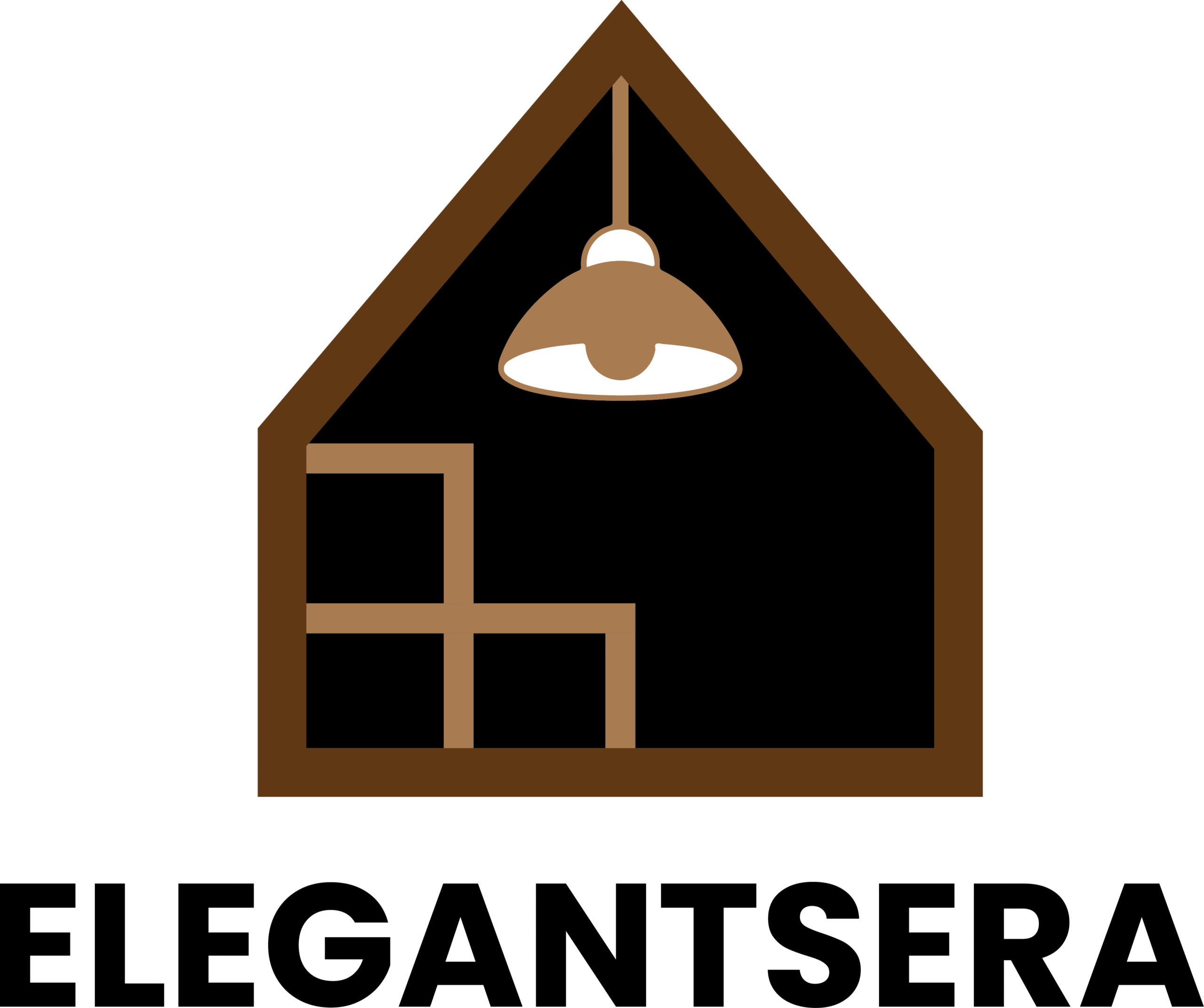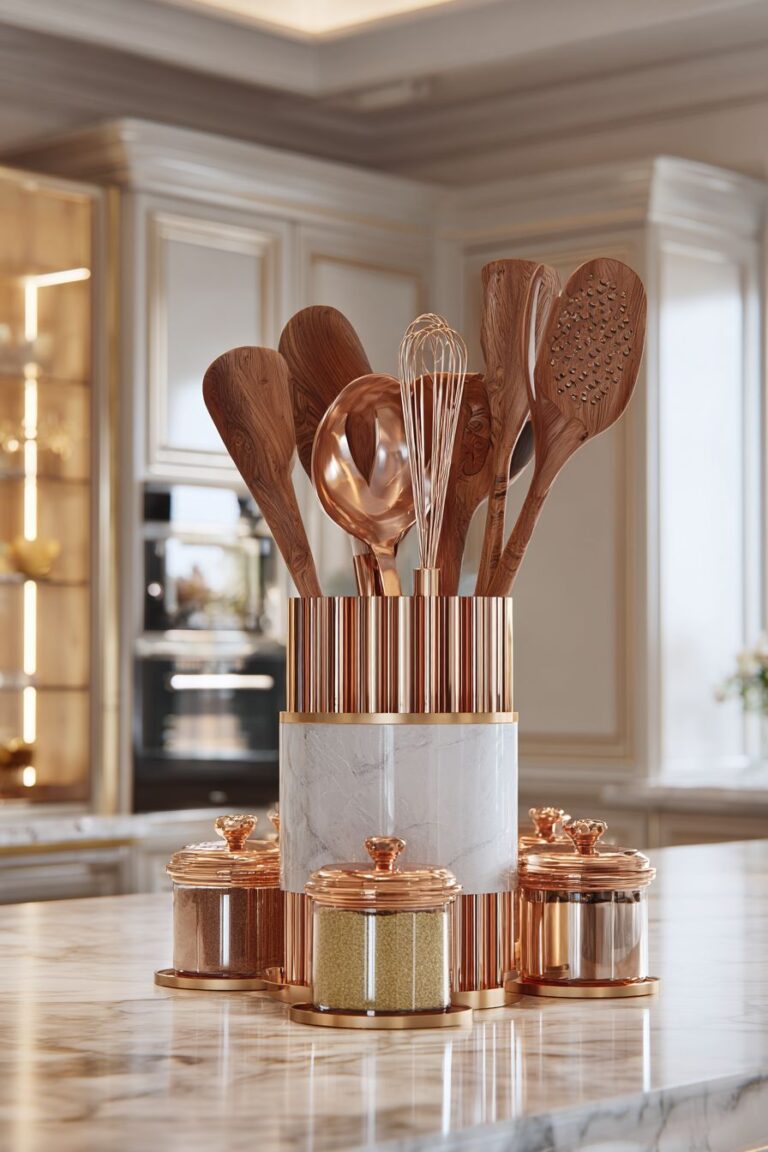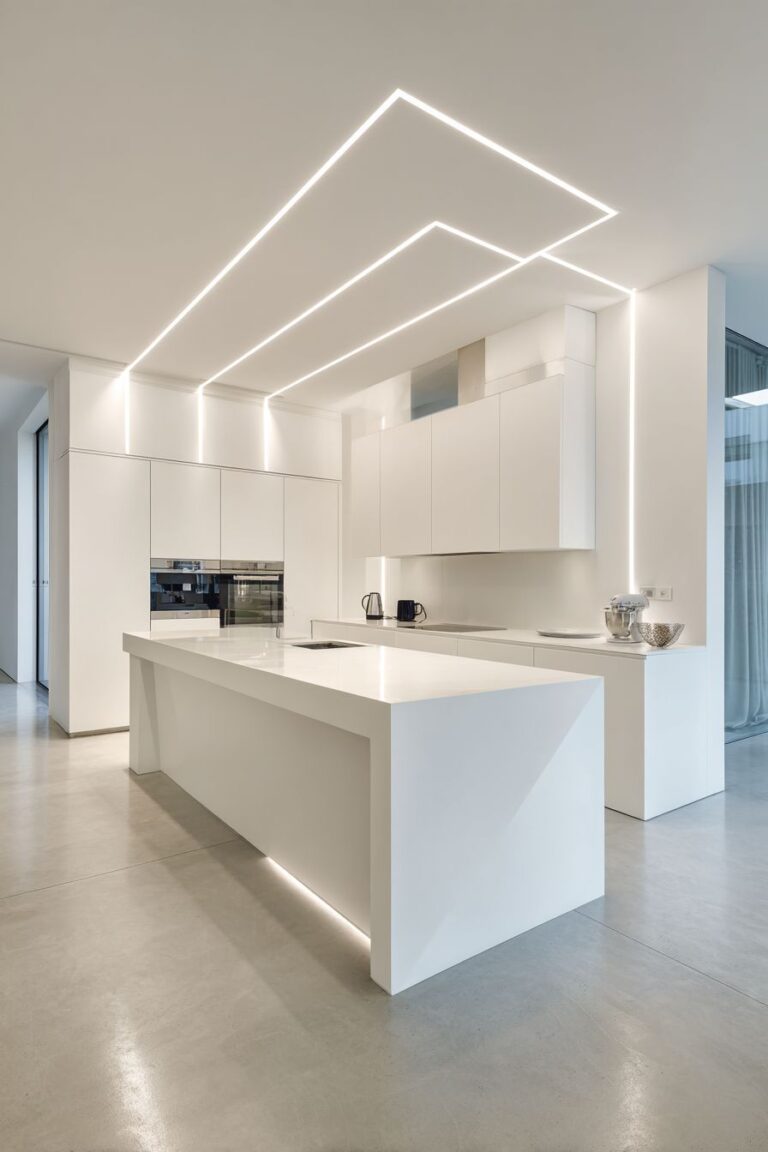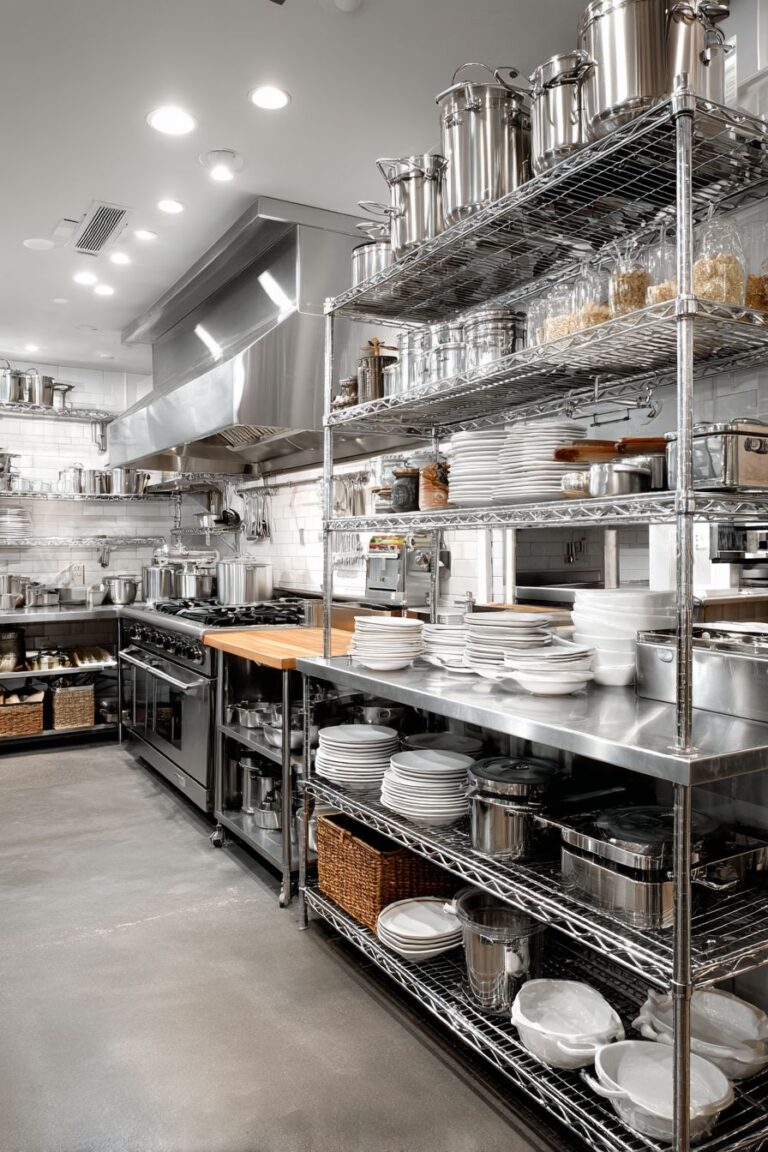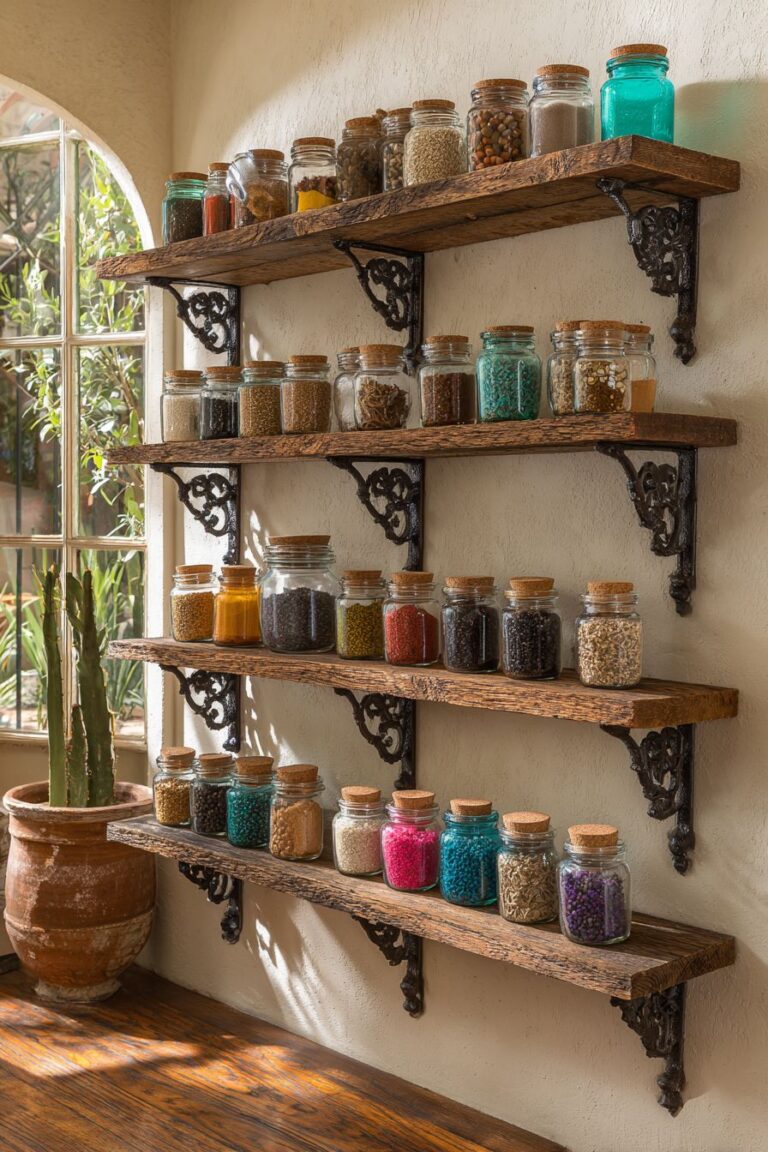20 Oak Kitchen Cabinets Ideas: Timeless Elegance And Versatile Design
In the world of interior design, few materials command as much respect and admiration as oak when it comes to kitchen cabinetry. Oak kitchen cabinets have stood the test of time, evolving from traditional farmhouse kitchens to sleek contemporary spaces, proving their remarkable versatility and enduring appeal. The natural beauty of oak wood, with its distinctive grain patterns and warm tones, creates an inviting atmosphere that transforms any kitchen into the heart of the home. Whether you’re planning a complete kitchen renovation or simply looking to refresh your current space, understanding the diverse applications and design possibilities of oak cabinetry will help you make informed decisions that enhance both functionality and aesthetic appeal.
The popularity of oak kitchen cabinets stems from their unique ability to complement virtually any design style while providing exceptional durability and longevity. From rich, honey-toned traditional cabinets with raised panel doors to sleek, minimalist Scandinavian-inspired designs with flat panels, oak adapts beautifully to different aesthetic preferences. The natural variations in oak’s grain patterns ensure that each cabinet is unique, adding character and authenticity to your kitchen design. Modern manufacturing techniques and finishing options have expanded the possibilities even further, allowing homeowners to enjoy everything from weathered rustic finishes to sophisticated painted treatments that still showcase the wood’s natural beauty.
This comprehensive guide explores twenty distinctive oak kitchen cabinet designs, each representing a different approach to incorporating this versatile hardwood into your culinary space. From compact galley kitchens that maximize every inch of storage to luxurious kitchen islands featuring book-matched oak veneers, these designs demonstrate the incredible range of possibilities available when working with oak cabinetry. Each concept offers practical insights, design tips, and inspiration for creating your own dream kitchen that balances beauty, functionality, and personal style.
1. Traditional Raised Panel Oak Kitchen Cabinets
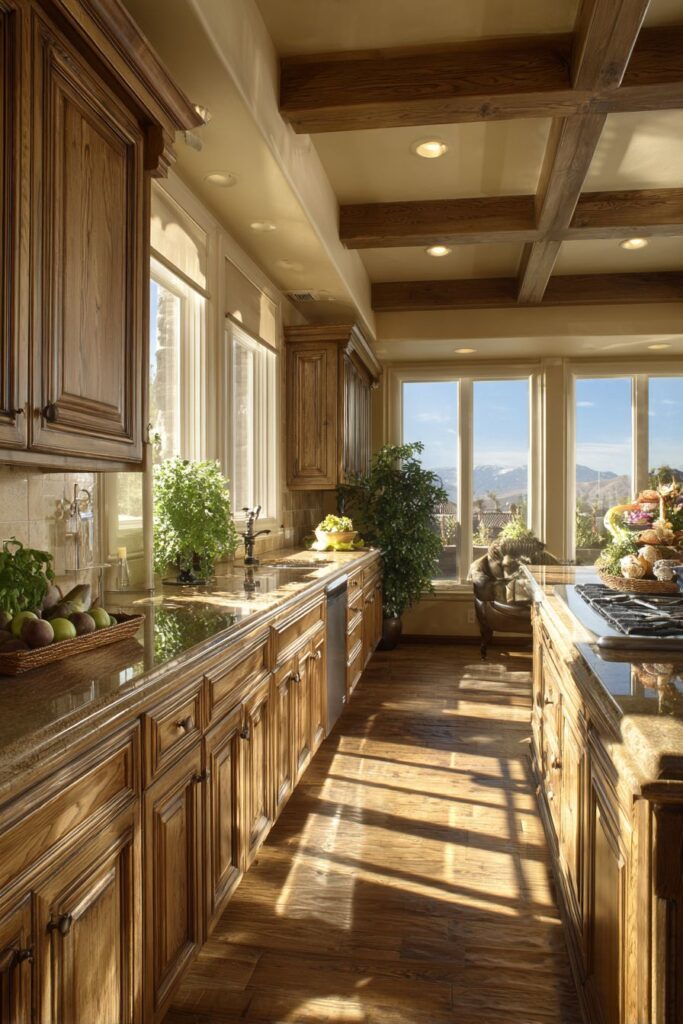
Step into a kitchen where rich, honey-toned oak kitchen cabinets with raised panel doors create an atmosphere of timeless elegance and warmth. The visible wood grain patterns tell the story of nature’s artistry, while the classic design elements speak to generations of craftsmanship tradition. These traditional oak cabinets feature both upper and lower units that maximize storage capacity while maintaining the authentic character that makes oak so beloved by homeowners and designers alike.
The beauty of traditional oak kitchen cabinets lies in their ability to create visual depth through the interplay of light and shadow across the raised panel surfaces. Natural light streaming through large windows illuminates every nuance of the wood’s grain, creating gentle shadows that highlight the dimensional quality of the cabinet doors. The warm honey tones of the oak provide a perfect backdrop for classic brass hardware, which adds both functionality and decorative appeal.
A large kitchen island with matching oak base serves as the centerpiece of this traditional design, providing additional workspace and storage while maintaining design continuity throughout the space. The island’s substantial presence anchors the room while offering practical benefits such as extra counter space for meal preparation and casual dining opportunities.
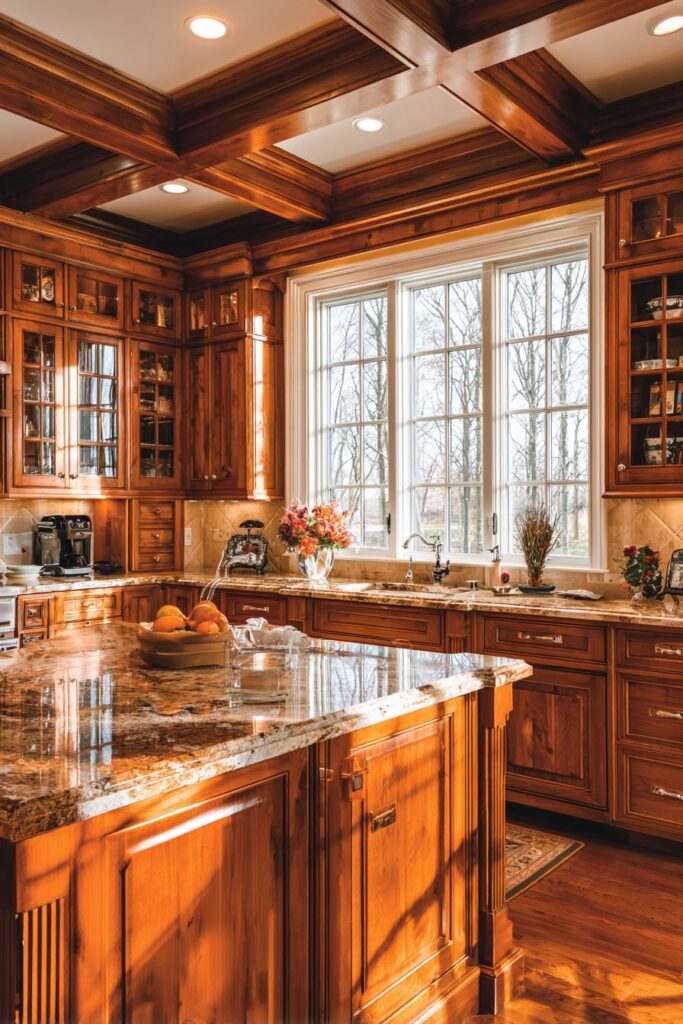
Key Design Tips for Traditional Oak Cabinets:
- Choose raised panel doors to emphasize the traditional aesthetic and showcase the wood’s natural beauty
- Incorporate classic brass hardware for authentic period-appropriate detailing
- Maximize natural light to highlight the oak’s warm honey tones and grain patterns
- Include a matching oak island to create visual continuity and additional functionality
- Select warm undertones in surrounding materials to complement the oak’s natural warmth
2. Modern Farmhouse Light Oak Kitchen Cabinets
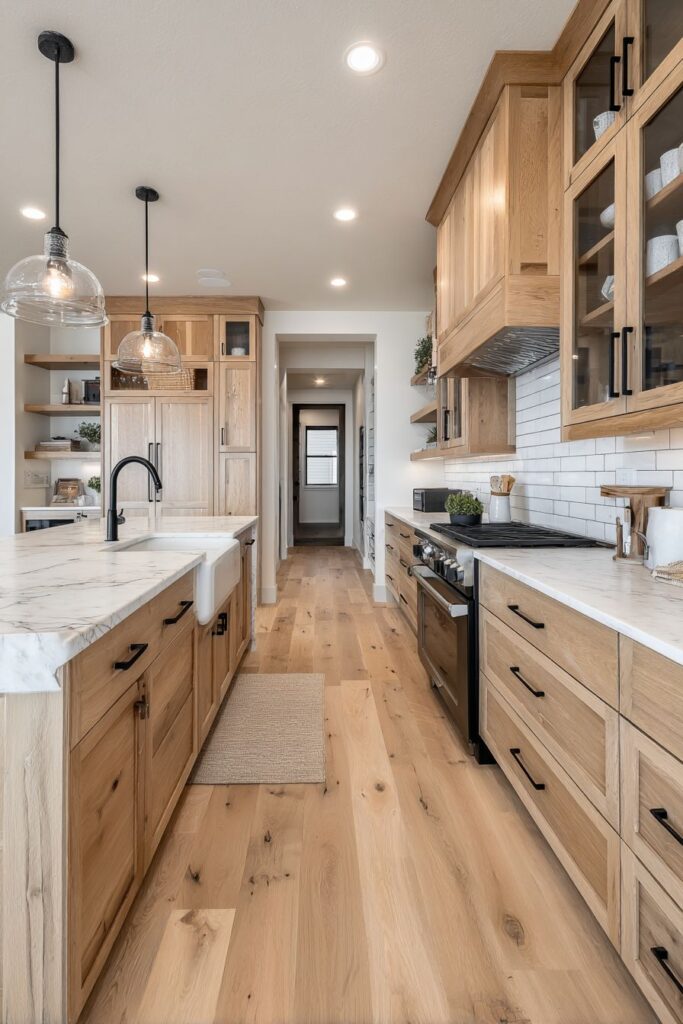
Modern farmhouse design reaches new heights of sophistication with light oak kitchen cabinets that feature clean lines and subtle grain patterns. This contemporary interpretation of rustic style showcases pale oak cabinetry with sleek black iron hardware, creating a perfect balance between traditional materials and modern aesthetics. The ceiling-height pantry unit demonstrates how oak can be used to maximize vertical storage while maintaining the clean, uncluttered look that defines modern farmhouse design.
The pale oak finish brings brightness and airiness to the kitchen while preserving the natural character that makes wood cabinetry so appealing. White quartz countertops provide a crisp contrast to the natural wood tones, while classic subway tile backsplash adds textural interest without overwhelming the space. This combination of materials creates a sophisticated color palette that feels both contemporary and timeless.
Pendant lighting over the kitchen island serves multiple purposes in this design, providing task lighting for food preparation while creating warm ambient light that enhances the oak’s natural character. The careful balance of artificial and natural lighting ensures that the wood’s beauty is showcased throughout the day, from bright morning sunlight to cozy evening illumination.

Key Design Elements for Modern Farmhouse Oak:
- Select light oak finishes to create brightness and visual expansion in the space
- Incorporate black iron hardware for authentic farmhouse character with modern appeal
- Add white quartz countertops to provide clean contrast against the natural wood
- Install ceiling-height cabinets to maximize storage while maintaining clean lines
- Use pendant lighting to create focal points and enhance the wood’s natural warmth
3. Rustic Weathered Oak Kitchen Cabinets
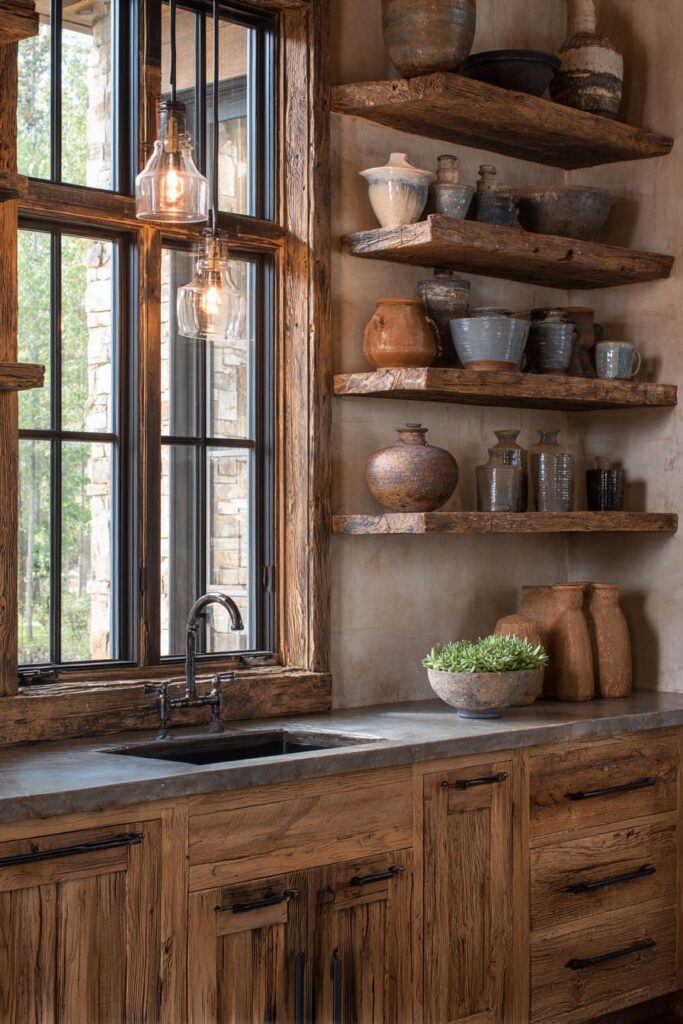
Embrace the beauty of time and craftsmanship with weathered oak kitchen cabinets that showcase distressed finishes and natural character marks. These rustic oak cabinets tell a story through their aged appearance, featuring natural knots and authentic wear patterns that speak to generations of use and care. Hand-forged iron hardware complements the organic nature of the weathered wood, creating an authentic rustic aesthetic that brings warmth and personality to any kitchen space.
The distressed finish on these oak cabinets creates visual depth and interest while highlighting the natural imperfections that make each piece unique. Open shelving units made from reclaimed oak provide additional storage and display opportunities for artisanal pottery and vintage kitchenware, further enhancing the lived-in charm of the space. The combination of closed cabinetry and open storage creates a balanced look that feels both practical and welcoming.
Warm Edison bulb lighting creates a cozy atmosphere that perfectly complements the rustic aesthetic, while natural daylight through farmhouse windows showcases the wood’s authentic patina. The interplay between artificial and natural lighting brings out the rich textures and varied tones within the weathered oak finish, creating a space that feels both historic and inviting.
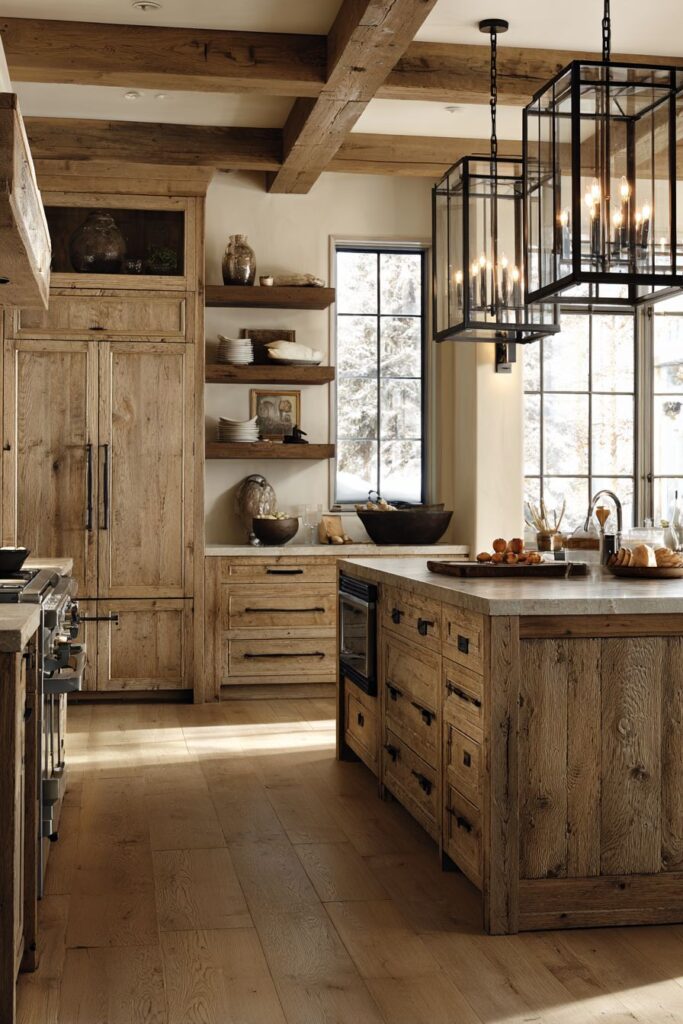
Essential Elements for Rustic Weathered Oak Design:
- Choose distressed finishes to emphasize the aged, authentic character of the wood
- Incorporate hand-forged hardware to complement the organic, handcrafted aesthetic
- Add open shelving made from reclaimed materials for additional rustic charm
- Use warm lighting to create cozy ambiance and highlight wood textures
- Display vintage items to enhance the lived-in, collected-over-time appearance
4. Scandinavian Bleached Oak Kitchen Cabinets
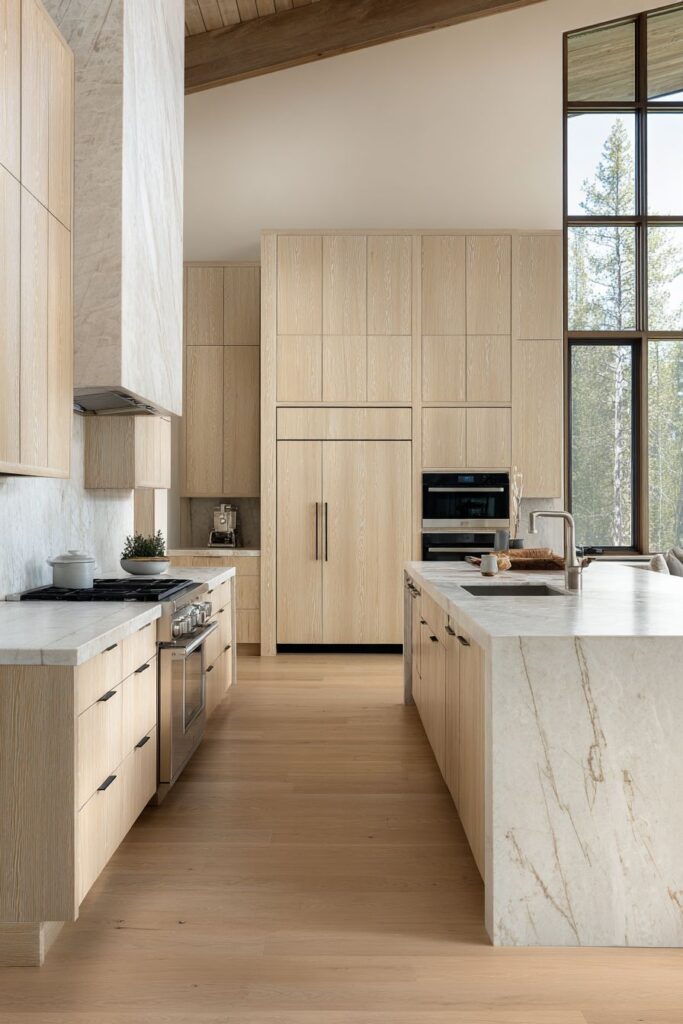
Scandinavian design principles come to life through bleached oak kitchen cabinets that embody minimalist flat-panel doors and integrated handles. The light-toned oak creates a serene, spa-like atmosphere that perfectly captures the essence of Nordic design philosophy. These pale oak cabinets serve as a neutral backdrop that allows other design elements to shine while providing the warmth and natural beauty that only wood can offer.
Floor-to-ceiling oak cabinetry maximizes storage capacity while maintaining the clean lines essential to Scandinavian aesthetics. The integrated handle design eliminates visual clutter, creating smooth, uninterrupted surfaces that emphasize the wood’s natural grain patterns. White marble countertops and stainless steel appliances complement the light oak finish, creating a harmonious palette that feels both sophisticated and approachable.
Soft natural lighting through large windows is crucial to this design approach, creating an airy atmosphere that highlights the oak’s pale, refined finish. The abundance of natural light not only showcases the beautiful wood grain but also contributes to the overall sense of openness and tranquility that defines Scandinavian interior design.

Scandinavian Oak Cabinet Design Principles:
- Select bleached or light finishes to create brightness and visual expansion
- Choose flat-panel doors with integrated handles for clean, minimalist lines
- Maximize natural light through large windows to enhance the pale wood tones
- Incorporate white marble countertops for sophisticated contrast and continuity
- Maintain floor-to-ceiling storage to optimize functionality without sacrificing aesthetics
5. Transitional Shaker-Style Oak Kitchen Cabinets

Transitional design finds perfect expression in medium-toned oak kitchen cabinets with classic shaker-style doors and brushed gold hardware. This approach successfully bridges the gap between traditional craftsmanship and contemporary functionality, creating a kitchen that feels both timeless and current. The oak’s natural grain provides visual warmth against crisp white walls and elegant marble backsplash with subtle veining, demonstrating how natural materials can anchor modern design schemes.
The shaker-style door design represents the epitome of functional beauty, with its simple frame-and-panel construction highlighting the oak’s natural characteristics while providing clean, geometric lines that work well in contemporary settings. A large kitchen island with oak base and a contrasting dark countertop serves as the room’s focal point, creating visual interest while providing essential workspace and storage.
Carefully planned lighting design includes both recessed ceiling fixtures and under-cabinet LED strips that illuminate work surfaces while highlighting the oak’s rich color depth. This layered lighting approach ensures that the kitchen remains functional throughout the day while showcasing the natural beauty of the wood grain patterns.

Transitional Oak Cabinet Design Features:
- Choose shaker-style doors for timeless appeal that bridges traditional and contemporary styles
- Select medium-toned finishes to provide warmth without overwhelming modern elements
- Add brushed gold hardware for sophisticated metallic accents that complement oak’s warm tones
- Create contrast with dark countertops against light oak cabinetry
- Layer lighting to highlight both functionality and natural wood beauty
6. Contemporary Dark-Stained Oak Kitchen Cabinets

Contemporary kitchen design reaches new levels of sophistication with dark-stained oak kitchen cabinets featuring sleek horizontal grain patterns and handleless design. The dramatic charcoal-toned oak finish creates stunning contrast against white quartz waterfall countertops, demonstrating how traditional materials can be transformed for modern applications. This bold approach to oak cabinetry proves that natural wood can be every bit as striking as manufactured materials in contemporary settings.
The horizontal grain orientation emphasizes the wood’s natural patterns while creating visual movement that draws the eye along the cabinet surfaces. Floor-to-ceiling cabinetry with integrated appliances creates a seamless, built-in appearance that exemplifies modern design principles of clean lines and hidden functionality. The dark stain allows the oak’s natural grain to show through while providing rich, sophisticated color that anchors the space.
Statement pendant lights over the kitchen island create dramatic focal points while natural light from clerestory windows provides balanced illumination that prevents the dark cabinets from feeling heavy or oppressive. This careful attention to lighting design ensures that the luxurious oak finish is properly showcased while maintaining the bright, airy feel essential to contemporary design.
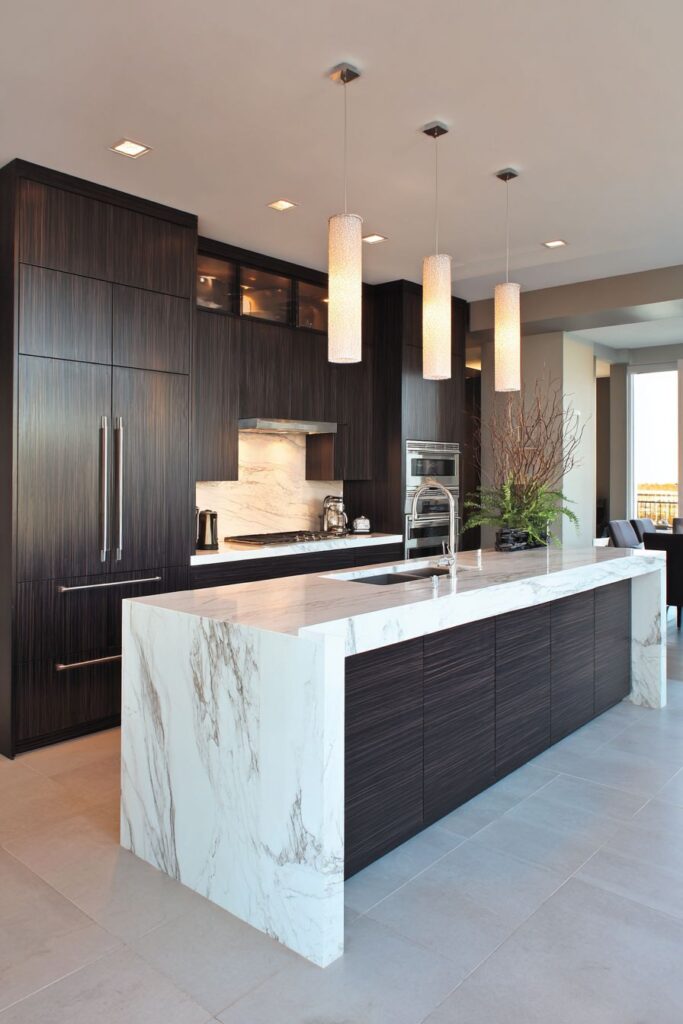
Contemporary Dark Oak Design Elements:
- Choose dark stains that allow grain patterns to show through for sophisticated depth
- Incorporate handleless designs for sleek, uninterrupted surfaces
- Add white countertops to create dramatic contrast against dark wood
- Use horizontal grain orientation to emphasize natural wood patterns
- Install statement lighting to create focal points and prevent the space from feeling dark
7. Compact Galley Oak Kitchen Cabinets

Small spaces receive maximum impact through custom oak kitchen cabinets designed specifically for galley kitchens, featuring clever storage solutions and soft-close mechanisms. The warm oak finish works particularly well in narrow spaces, as the natural wood tones help brighten and visually expand the area while providing the storage capacity essential in compact kitchens. Pull-out drawers and vertical dividers optimize every inch of available space, proving that oak cabinetry can be both beautiful and incredibly functional.
Upper cabinets extending to the ceiling maximize vertical storage while glass inserts in select doors provide visual relief and display opportunities for curated dishware. This combination of solid and glass-front doors prevents the space from feeling closed-in while maintaining the storage capacity needed in smaller kitchens. The thoughtful design proves that size limitations don’t have to compromise style or functionality.
Under-cabinet lighting serves dual purposes in this compact design, providing essential task lighting for food preparation while creating ambient illumination that highlights the oak’s inviting grain patterns. A strategically placed skylight brings natural light into the narrow space, further emphasizing the wood’s natural beauty and creating the illusion of greater space.
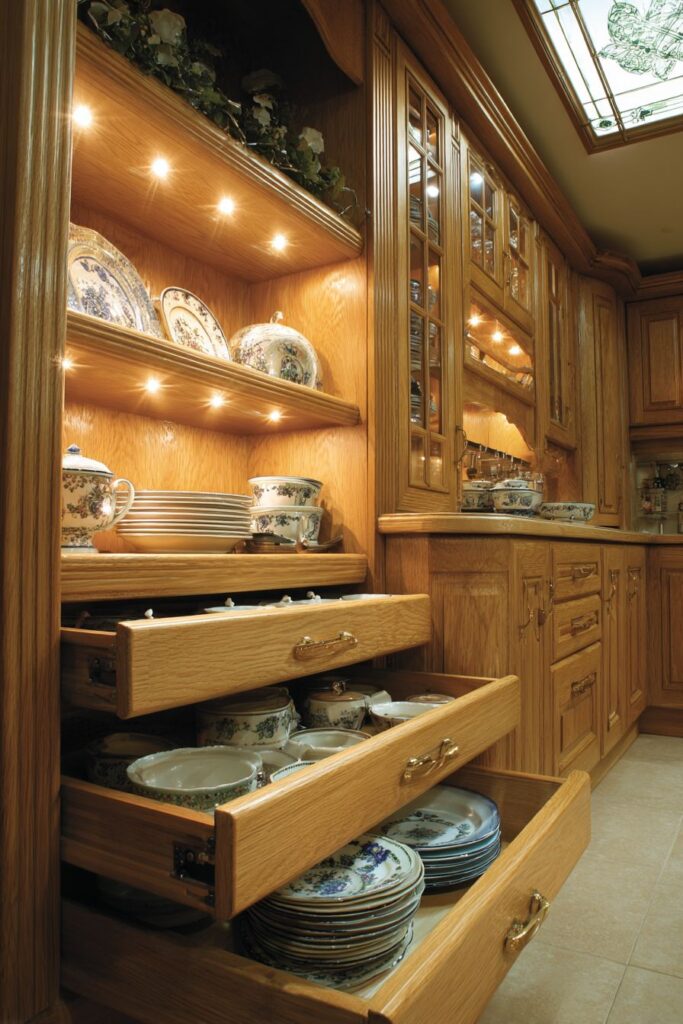
Compact Oak Kitchen Design Strategies:
- Maximize vertical space with ceiling-height cabinetry and clever storage solutions
- Choose warm oak finishes to brighten small spaces naturally
- Incorporate pull-out storage to make deep cabinets more accessible and functional
- Add glass-front doors to create visual relief and prevent cramped feelings
- Use under-cabinet lighting to illuminate work surfaces and highlight wood grain
8. Luxury Book-Matched Oak Kitchen Island
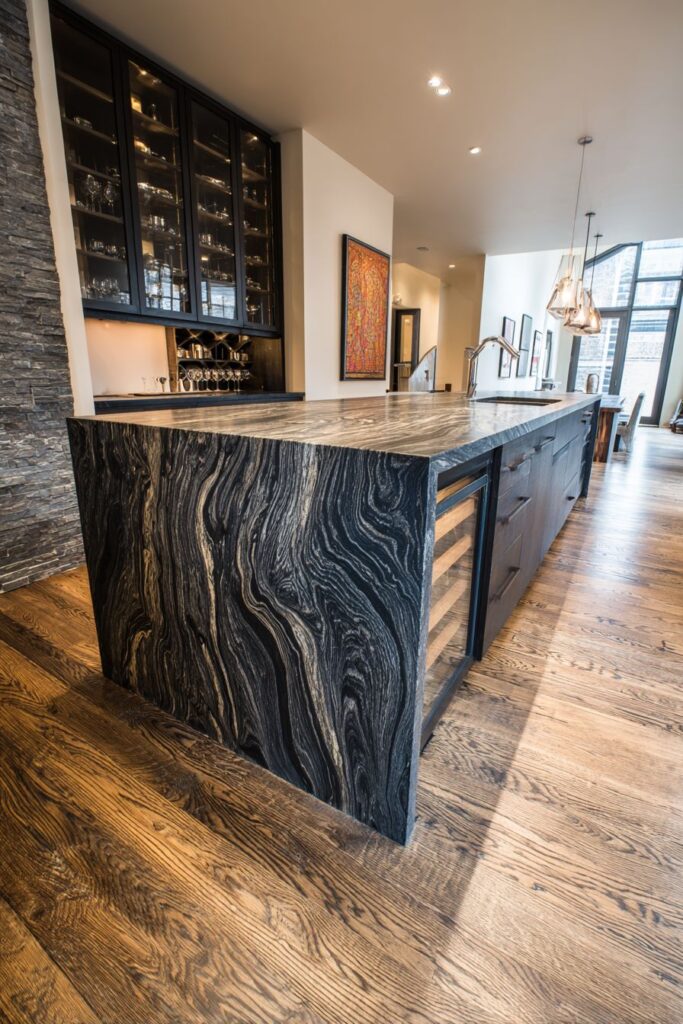
Luxury kitchen design reaches its pinnacle with a book-matched oak kitchen island featuring cathedral grain patterns that create stunning mirror-image symmetry. This artistic approach to cabinetry showcases the natural beauty of oak veneer while demonstrating the highest levels of woodworking craftsmanship. The dramatic grain flow creates visual interest that rivals any piece of fine furniture, elevating the kitchen island from functional element to artistic centerpiece.
The book-matching technique requires careful selection and matching of oak veneers to create the symmetrical pattern, resulting in a truly unique design element that cannot be replicated. Waterfall-edge countertops in dark granite provide striking contrast to the natural wood while creating clean, contemporary lines that balance the organic patterns in the oak grain. This combination of natural and manufactured materials exemplifies luxury kitchen design at its finest.
Built-in wine storage and custom drawer systems demonstrate how functional elegance can be seamlessly integrated into artistic design. Every element serves a purpose while contributing to the overall aesthetic appeal, proving that luxury doesn’t have to sacrifice practicality. Architectural lighting creates dramatic shadows that emphasize the spectacular grain flow, turning the kitchen island into a sculptural element that commands attention.
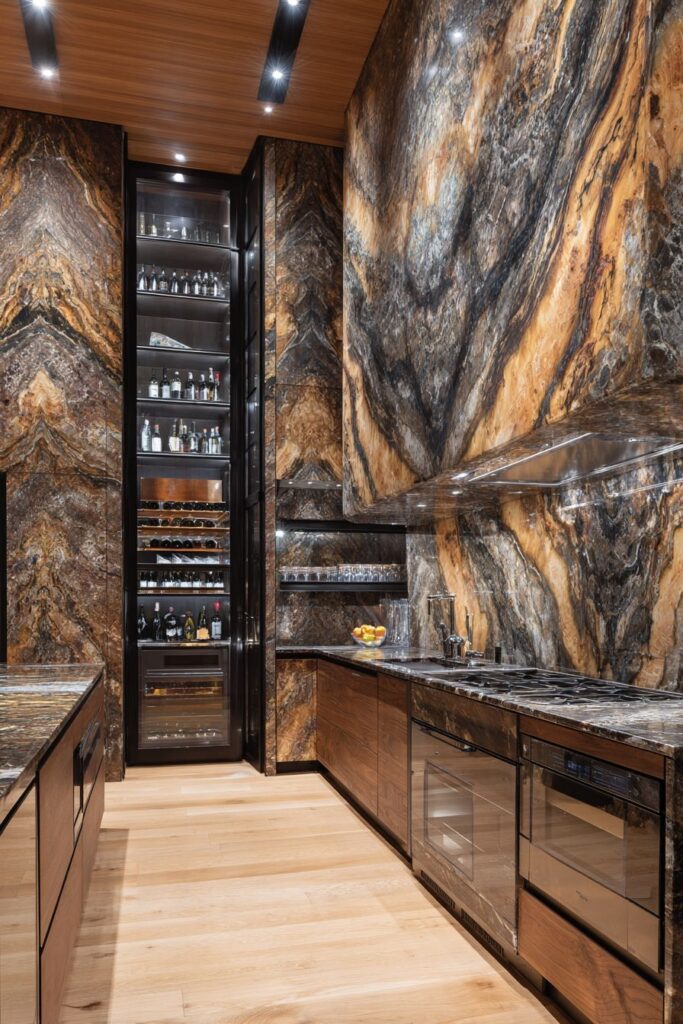
Luxury Book-Matched Oak Design Features:
- Select premium oak veneers with dramatic cathedral grain patterns for maximum visual impact
- Create mirror-image symmetry through careful book-matching techniques
- Add waterfall countertops for contemporary contrast against organic wood patterns
- Incorporate wine storage and custom organization systems for functional luxury
- Use architectural lighting to create dramatic shadows that emphasize grain patterns
9. Cottage-Style Painted Oak Kitchen Cabinets
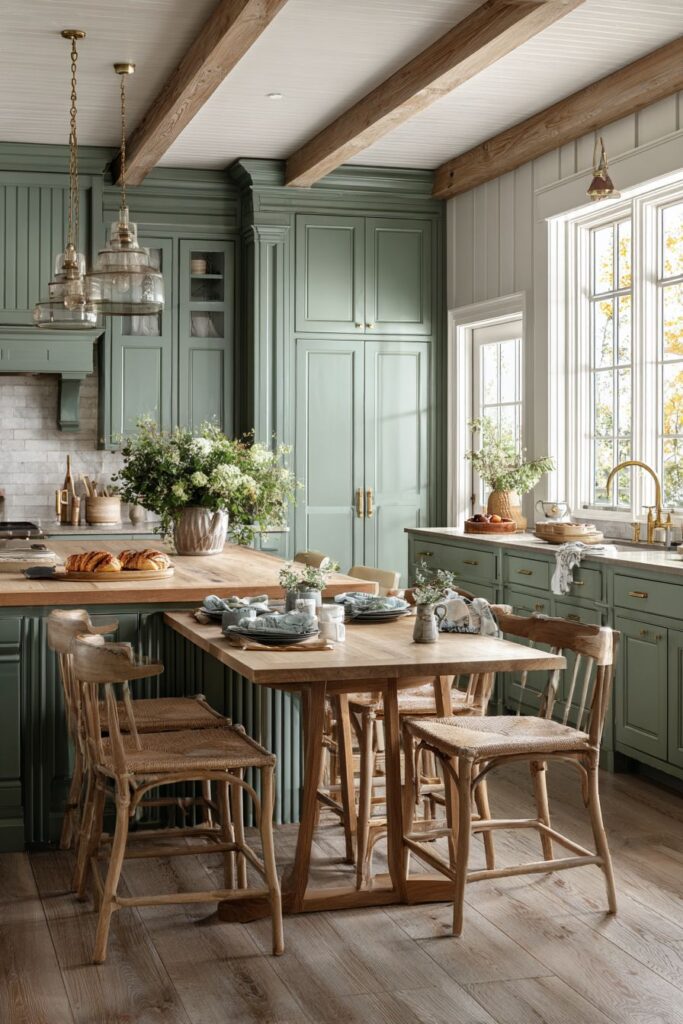
Cottage charm comes alive through painted oak kitchen cabinets in sage green with natural oak interiors visible when doors are opened. This creative approach maintains the authentic character of oak wood while introducing color that enhances the cozy, lived-in appeal of cottage-style design. The combination of painted exterior finish and exposed oak interiors creates visual interest while demonstrating the wood’s versatility and natural beauty.
Beadboard backsplash and butcher block countertops enhance the country aesthetic while providing practical surfaces that age beautifully over time. These traditional materials work in harmony with the painted oak cabinetry to create a cohesive design that feels both historical and fresh. The sage green paint color provides a sophisticated alternative to typical white cottage kitchens while maintaining the light, airy feeling essential to the style.
Warm pendant lighting over the breakfast nook creates intimate ambiance that encourages family gathering and casual dining. Natural light through cottage-style windows showcases the thoughtful color palette and highlights the contrast between painted and natural oak finishes. This careful attention to lighting ensures that both the paint color and wood grain are properly displayed throughout the day.
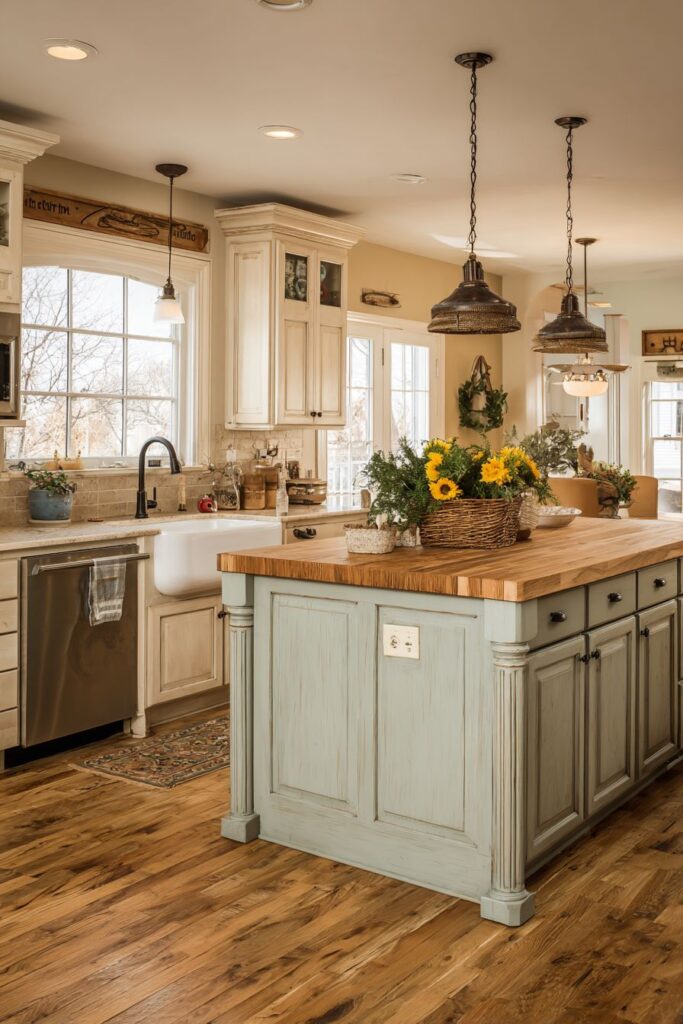
Cottage-Style Painted Oak Elements:
- Choose muted paint colors like sage green that complement natural oak tones
- Maintain natural oak interiors to preserve wood character and authenticity
- Add traditional materials like beadboard and butcher block for cohesive cottage appeal
- Create intimate lighting over dining areas to encourage family gathering
- Preserve wood character by showing natural oak in strategic locations
10. Vintage Restored Oak Kitchen Cabinets
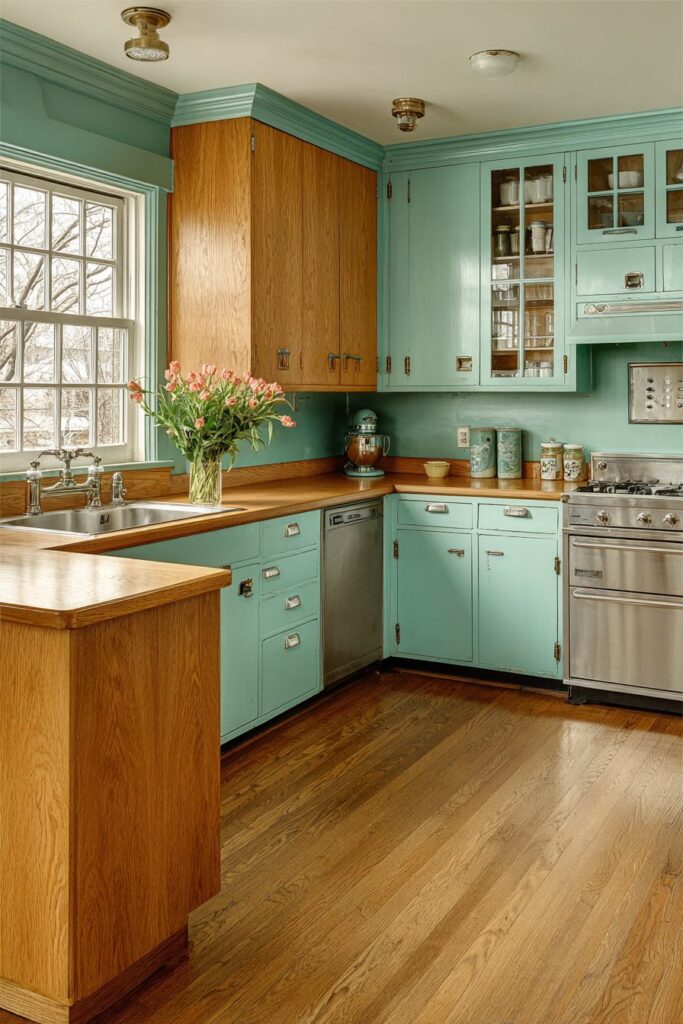
Historical preservation meets modern functionality in refinished vintage oak kitchen cabinets with original 1950s hardware restored to mint condition. This approach to kitchen renovation celebrates the quality and craftsmanship of mid-century cabinetry while updating functionality for contemporary lifestyles. The honey-colored oak displays decades of character development while modern stainless appliances provide the convenience expected in today’s kitchens.
Original details such as glass-front upper cabinets and built-in spice racks demonstrate the thoughtful design that characterized quality cabinetry from earlier eras. These functional elements continue to serve their original purpose while adding historical interest and authentic character to the renovated space. The successful integration of vintage elements with modern appliances proves that quality craftsmanship never goes out of style.
Natural light through period-appropriate windows highlights both the oak’s beautiful patina and the quality of the restoration work. The careful attention to preserving original details while updating functionality creates a kitchen that honors its history while serving contemporary needs. This approach to renovation demonstrates the sustainability and enduring value of quality oak cabinetry.

Vintage Oak Restoration Principles:
- Preserve original hardware whenever possible for authentic historical character
- Maintain period-appropriate details like glass fronts and built-in storage features
- Update functionality while preserving the visual integrity of vintage design
- Highlight natural patina developed over decades of use and aging
- Integrate modern appliances thoughtfully to maintain historical authenticity
11. Coastal White-Washed Oak Kitchen Cabinets
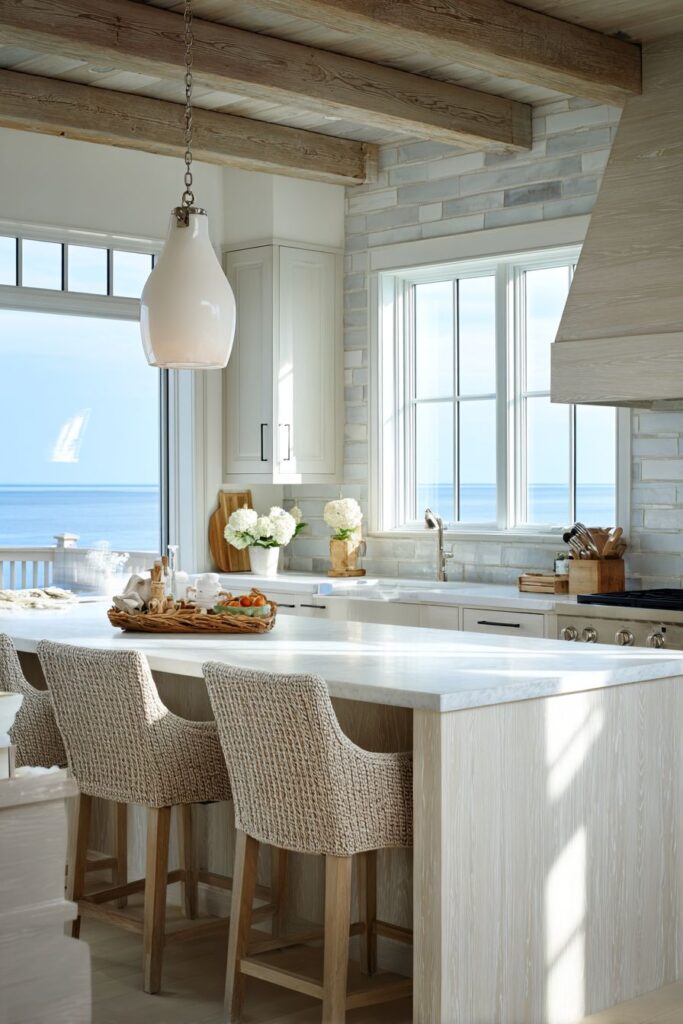
Coastal elegance finds expression through white-washed oak kitchen cabinets that maintain visible wood grain through translucent finishing techniques. This ethereal treatment preserves oak’s natural texture while creating a bright, beach-inspired aesthetic that brings the serenity of coastal living indoors. The technique allows the wood’s character to show through while providing the light, airy feeling essential to coastal design themes.
Marble countertops and classic subway tile backsplash complement the light finish while providing the crisp, clean surfaces that define coastal style. The combination of natural wood and pristine white materials creates a sophisticated palette that feels both relaxed and refined. Large windows flood the space with natural light that plays across the subtle wood grain patterns, creating ever-changing visual interest throughout the day.
The white-washing technique requires skill to achieve the perfect balance between covering and revealing the wood’s natural character. When done correctly, it creates depth and interest while maintaining the brightness essential to coastal design. This finish proves that oak can be transformed to suit any design aesthetic while retaining its inherent beauty and character.

Coastal White-Washed Oak Features:
- Use translucent finishes that allow natural grain patterns to show through
- Maximize natural light to enhance the ethereal quality of white-washed finishes
- Add marble countertops for crisp contrast and coastal sophistication
- Choose light hardware that doesn’t compete with the delicate finish
- Create brightness while preserving the wood’s natural character and texture
12. Butler’s Pantry Floor-to-Ceiling Oak Storage
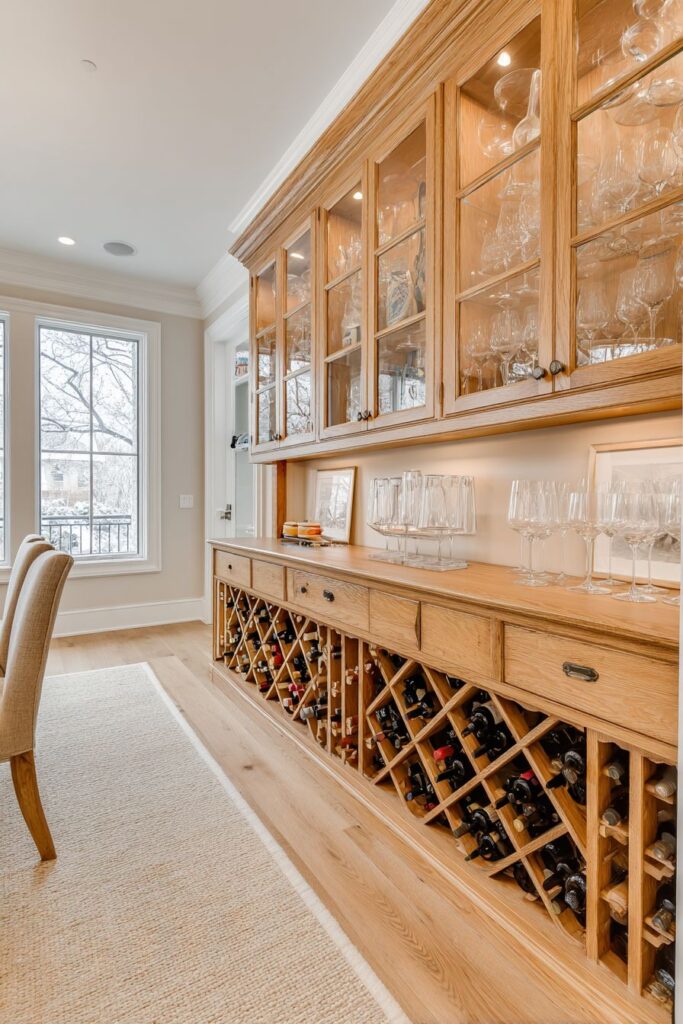
Sophisticated organization reaches new heights in a butler’s pantry featuring floor-to-ceiling oak kitchen cabinets with adjustable shelving and integrated wine storage. This dedicated storage space maximizes capacity while maintaining the elegant appearance that makes oak cabinetry so desirable. The rich oak finish provides warmth and character in what could otherwise be a purely utilitarian space, proving that storage areas can be both functional and beautiful.
Glass-front upper cabinets display fine china and glassware while lower drawers organize linens and serving pieces with precision and style. The combination of display and concealed storage creates visual interest while providing the organization with essential to formal entertaining. LED strip lighting illuminates each shelf level, ensuring that stored items are easily visible while highlighting the oak’s consistent grain pattern.
The design demonstrates how oak cabinetry can transform auxiliary spaces into sophisticated extensions of the main kitchen. Natural light from adjacent windows showcases the wood’s beautiful grain while the organized storage systems prove that functionality and beauty can coexist harmoniously. This approach to pantry design elevates storage from necessity to design feature.
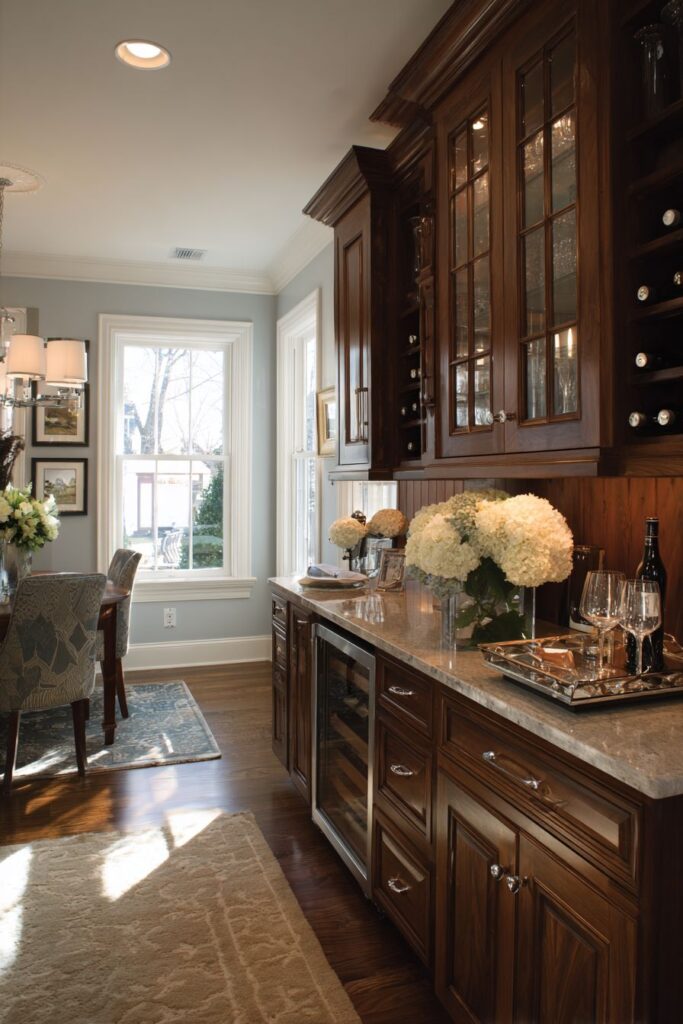
Butler’s Pantry Oak Design Elements:
- Maximize vertical storage with floor-to-ceiling cabinetry and adjustable shelving
- Combine display and concealed storage for both function and visual interest
- Add integrated wine storage for sophisticated entertaining capabilities
- Use LED strip lighting to illuminate stored items and highlight wood grain
- Maintain consistent finishes to create visual continuity with main kitchen areas
13. Built-In Breakfast Nook Oak Seating
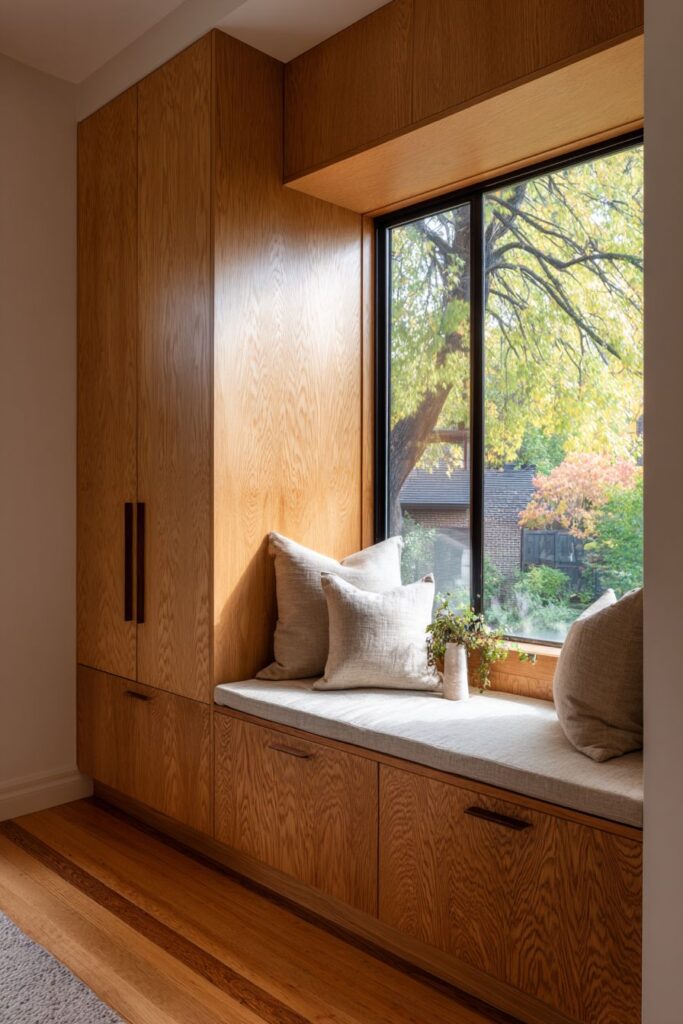
Family-friendly design comes to life in a breakfast nook featuring built-in oak kitchen cabinets with bench seating and hidden storage compartments. This integrated approach creates a cozy dining alcove while providing practical storage solutions for table linens, games, and seasonal items. The warm oak creates an inviting atmosphere that encourages family meals and casual conversation while maximizing the functionality of every square inch.
Cushioned seating in natural linen complements the oak’s warm tones while providing comfort for extended dining sessions. The storage compartments beneath the seating are accessed through lift-up seats or pull-out drawers, demonstrating how form and function can be seamlessly integrated. Large windows offer garden views while flooding the space with natural light that highlights the wood’s grain patterns.
The breakfast nook design proves that oak cabinetry can extend beyond traditional kitchen storage to create specialized spaces that enhance family living. The combination of seating, storage, and natural materials creates a space that feels both practical and welcoming. This approach to kitchen design recognizes that modern families need versatile spaces that adapt to multiple uses throughout the day.

Breakfast Nook Oak Design Features:
- Integrate storage into seating areas to maximize space efficiency
- Choose comfortable cushioning in natural materials that complement oak tones
- Add large windows for natural light and connection to outdoor spaces
- Create cozy alcoves that encourage family gathering and conversation
- Design multi-functional spaces that serve both dining and storage needs
14. Home Office Integration Oak Kitchen Workspace
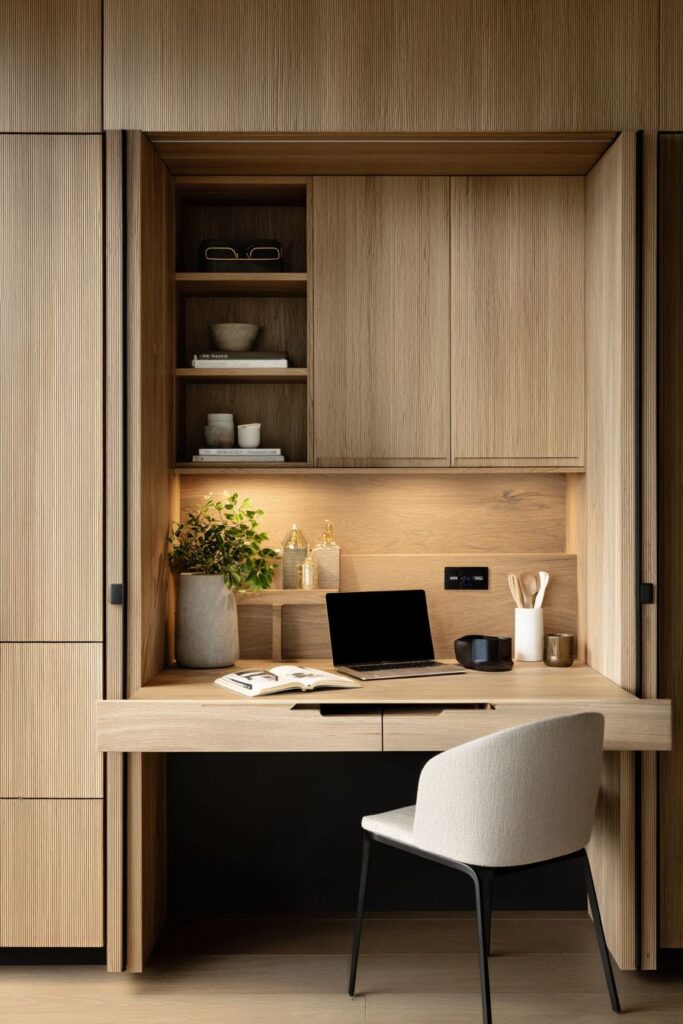
Modern family life receives thoughtful accommodation through oak kitchen cabinets integrated with desk areas and charging stations for contemporary needs. This seamless design approach extends the kitchen’s visual continuity while creating dedicated workspace for homework, bill paying, and digital device management. The oak finish provides warmth and character to what could otherwise be a sterile computer station.
Built-in file drawers and open shelving provide organization for both kitchen and office supplies while maintaining the space’s aesthetic flow. The integration of workspace into kitchen design recognizes how modern families use their homes, creating multi-functional spaces that adapt to changing needs throughout the day. Task lighting illuminates work surfaces while natural oak grain adds warmth to the functional area.
This design approach demonstrates the evolution of kitchen planning to meet contemporary lifestyle demands. The oak cabinetry provides visual continuity while accommodating new functions that weren’t considered in traditional kitchen design. The result is a space that serves multiple purposes while maintaining the warmth and beauty that make oak so appealing.
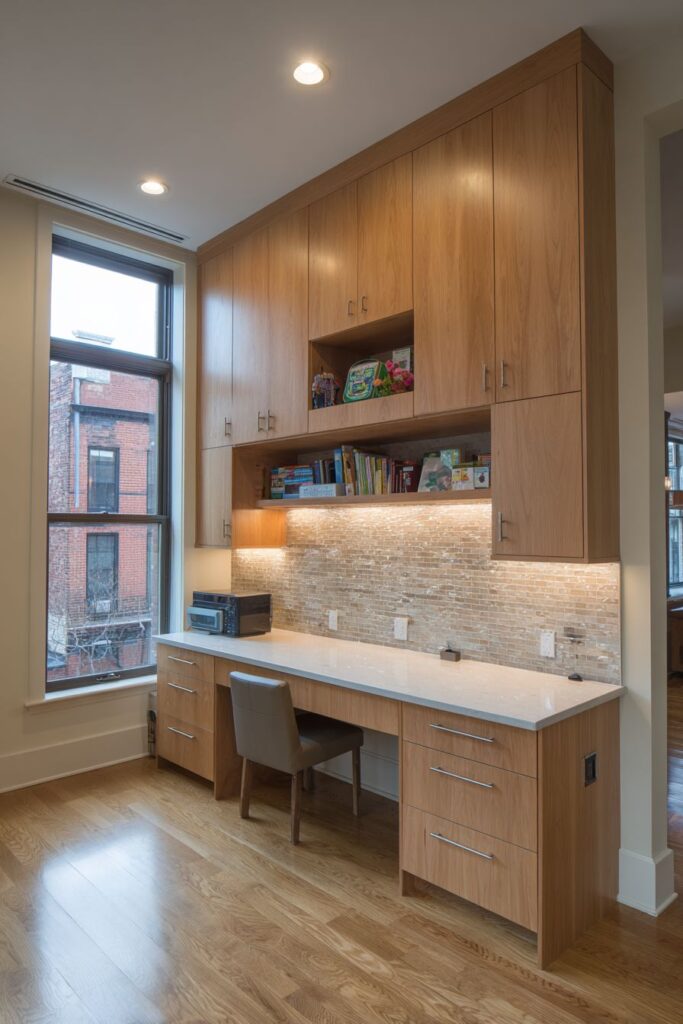
Integrated Workspace Oak Design Elements:
- Create visual continuity between kitchen storage and workspace areas
- Add built-in organization for both kitchen and office supplies
- Incorporate charging stations for modern digital device management
- Use task lighting to illuminate work surfaces effectively
- Design multi-functional spaces that adapt to contemporary family needs
15. Corner Storage Innovation Oak Solutions
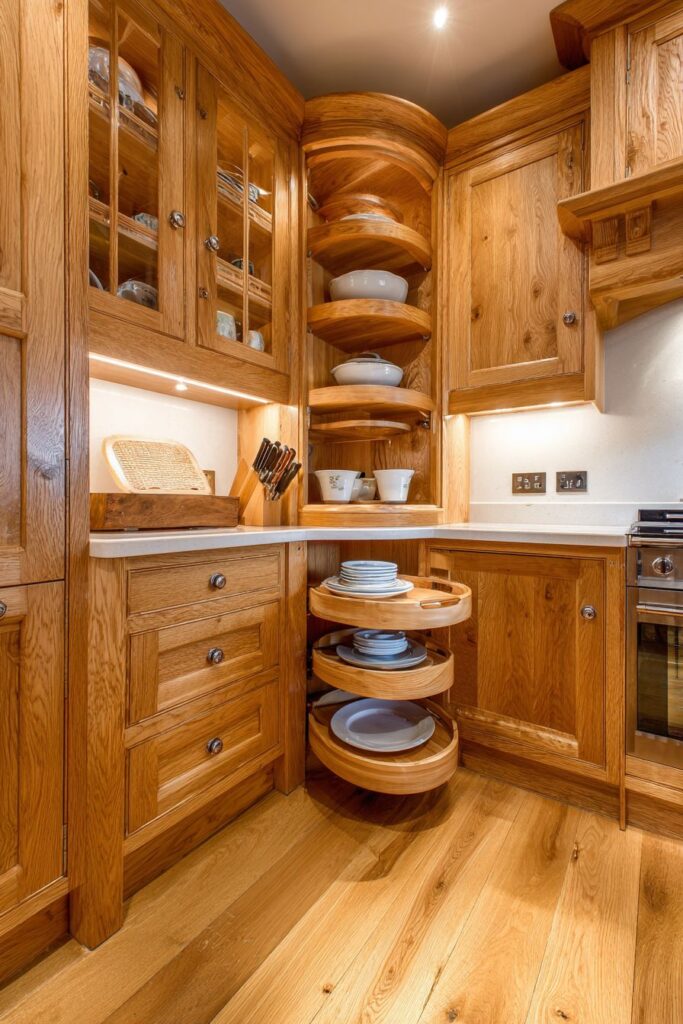
Innovative storage design reaches new levels of functionality through oak kitchen cabinets featuring lazy Susan systems and pull-out storage that maximizes difficult corner access. These clever solutions prove that oak cabinetry can incorporate cutting-edge storage technology while maintaining traditional aesthetic appeal. The natural grain flows continuously around corner units while soft-close mechanisms ensure smooth, quiet operation.
Interior LED lighting activates automatically when doors open, illuminating stored items and making corner spaces truly functional. This thoughtful integration of technology with traditional materials demonstrates how modern convenience can enhance rather than detract from natural wood beauty. The oak finish provides warmth and character while the innovative storage systems maximize accessibility and organization.
Professional installation ensures that mechanical precision works in harmony with natural wood beauty, creating storage solutions that are both practical and aesthetically pleasing. The design proves that traditional materials can embrace modern functionality while maintaining their inherent appeal and character.
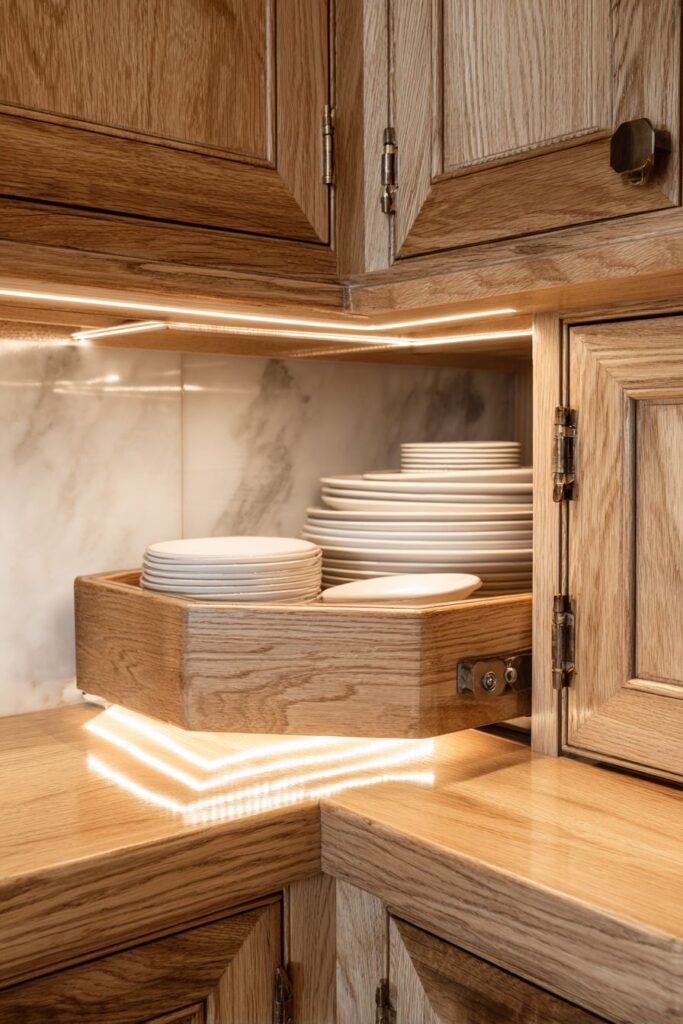
Corner Storage Oak Innovation Features:
- Incorporate lazy Susan systems for maximum corner accessibility and organization
- Add automatic LED lighting that activates when doors open
- Choose soft-close mechanisms for smooth, quiet operation
- Maintain continuous grain flow around corner units for visual continuity
- Integrate modern technology while preserving traditional oak character
16. Dedicated Coffee Station Oak Cabinetry
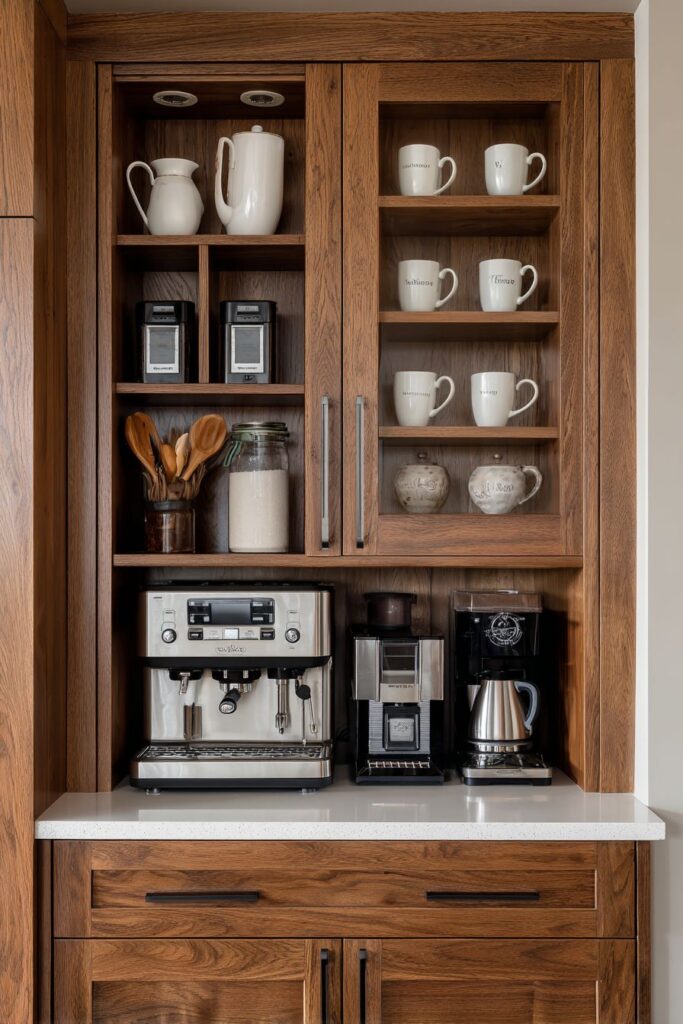
Luxury morning routines receive proper accommodation through dedicated oak kitchen cabinets housing built-in espresso machines and coffee accessories. This specialized design approach creates a sophisticated beverage center that rivals commercial coffee shops while maintaining the warmth and character of residential oak cabinetry. Rich oak finishes provide an elegant backdrop for high-end appliances while specialized compartments organize everything needed for the perfect cup.
Steam venting and electrical integration are seamlessly incorporated into the oak cabinet design, proving that traditional materials can accommodate the most sophisticated modern appliances. Under-cabinet lighting creates perfect ambiance for morning coffee rituals while highlighting the wood’s warm character. The design demonstrates how oak cabinetry can create luxury experiences within the home environment.
Specialized storage solutions include temperature-controlled compartments for coffee beans, dedicated spaces for cups and saucers, and integrated waste disposal for coffee grounds. Every element is designed to enhance the coffee experience while maintaining the beautiful appearance that makes oak cabinetry so desirable in luxury kitchens.
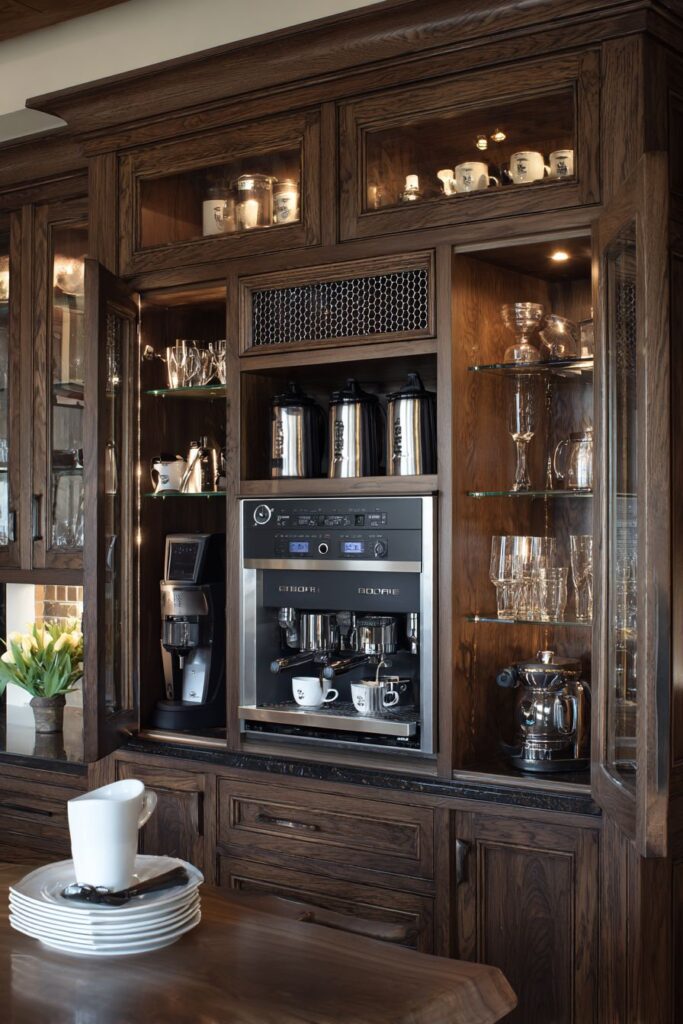
Coffee Station Oak Design Elements:
- Create dedicated appliance housing for built-in espresso machines and accessories
- Integrate utility requirements like steam venting and electrical connections seamlessly
- Add specialized storage for coffee beans, cups, and accessories
- Use warm lighting to create perfect morning ambiance
- Design luxury experiences that rival commercial coffee establishments
17. Traditional Farmhouse Sink Oak Cabinetry
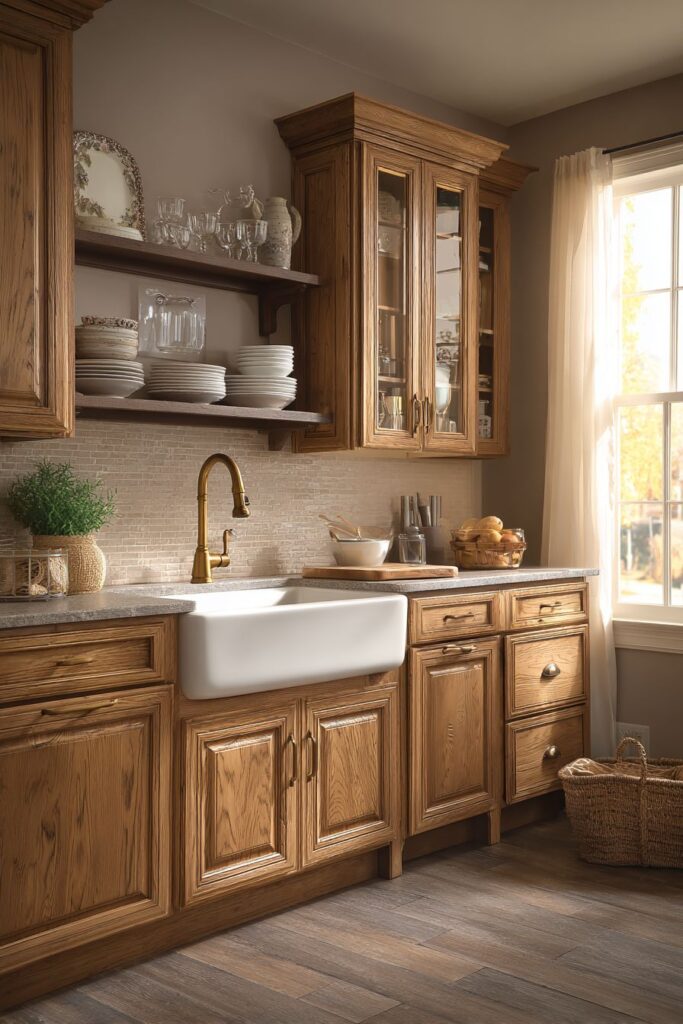
Traditional farmhouse charm finds perfect expression in oak kitchen cabinets surrounding an apron-front sink with period-appropriate styling. The oak’s honey tones complement aged brass faucets and hardware while maintaining the authentic character essential to farmhouse design. This classic combination creates a workspace that feels both historical and timeless, proving that traditional design approaches continue to resonate with contemporary homeowners.
Open shelving above the sink displays vintage dishware while lower cabinets conceal modern conveniences like dishwashers and garbage disposals. This thoughtful integration of old and new demonstrates how traditional aesthetics can accommodate modern functionality without compromising authenticity. The oak’s natural grain adds texture and warmth while brass accents provide metallic highlights that enhance the overall design.
Natural light through cafe curtains creates gentle, diffused illumination that showcases the oak’s natural beauty while maintaining privacy. The farmhouse sink becomes the focal point of a workspace that celebrates traditional craftsmanship while providing the convenience expected in contemporary kitchens. This approach to kitchen design honors historical precedents while serving modern needs.
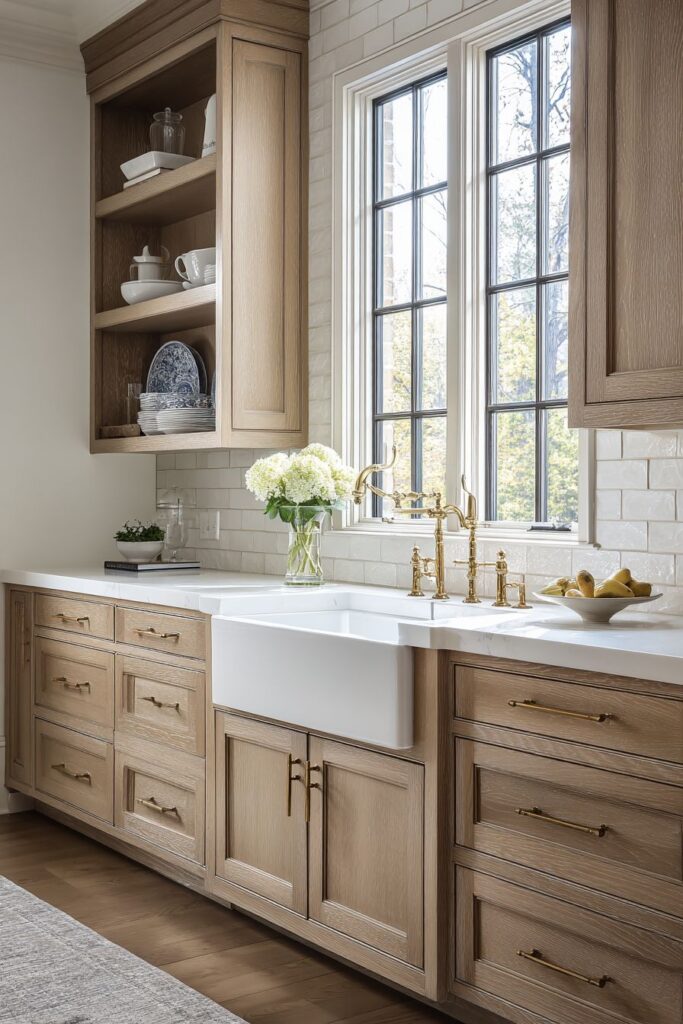
Farmhouse Sink Oak Design Features:
- Choose apron-front sinks that complement traditional oak cabinetry styling
- Add aged brass hardware for authentic farmhouse character and visual warmth
- Incorporate open shelving for display of vintage dishware and accessories
- Use cafe curtains for gentle light filtering and traditional window treatments
- Balance historical authenticity with modern convenience and functionality
18. Specialized Baking Center Oak Storage
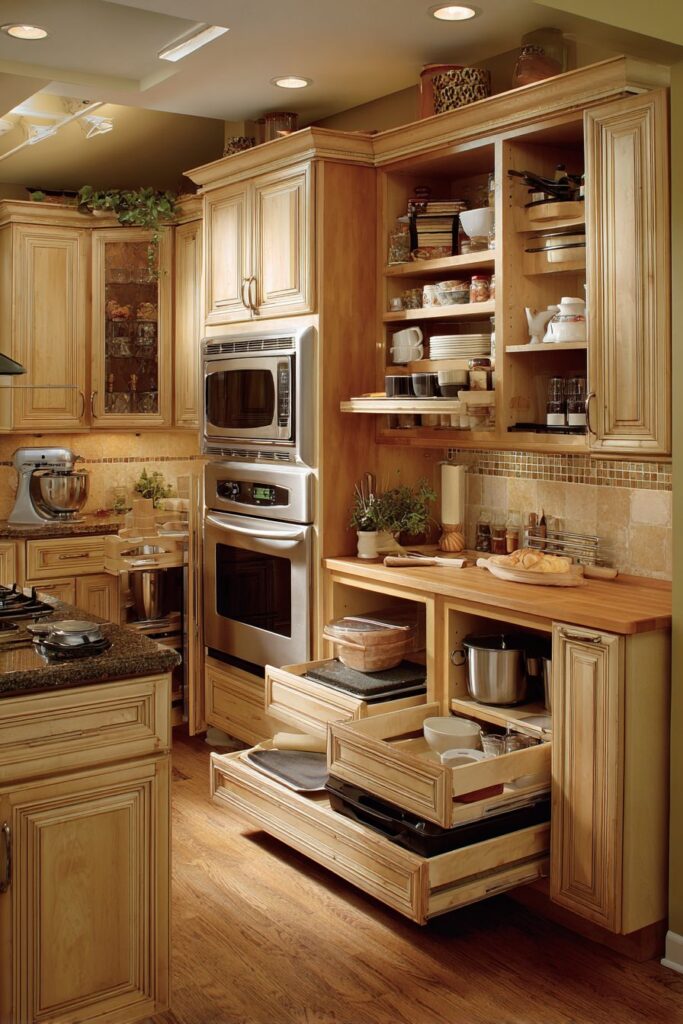
Dedicated baking receives proper accommodation through oak kitchen cabinets designed specifically for mixing bowls, baking sheets, and specialized appliances. The oak’s warm finish creates an inviting workspace while pull-out shelves and vertical dividers optimize organization for serious baking enthusiasts. This specialized approach to kitchen design recognizes that passionate cooks need dedicated spaces equipped for specific culinary pursuits.
Butcher block countertops complement the oak cabinetry while providing ideal surfaces for pastry preparation and bread kneading. The natural wood combination creates warmth and authenticity while offering the functional benefits that serious bakers require. Flour bins and spice storage integrate seamlessly into the cabinetry design, keeping essential ingredients organized and easily accessible.
Strategic lighting highlights both the functional aspects of the baking center and the oak’s natural grain patterns, creating a workspace that is both practical and beautiful. The design demonstrates how oak cabinetry can be customized to support specific hobbies and interests while maintaining the aesthetic appeal that makes wood cabinetry so desirable.
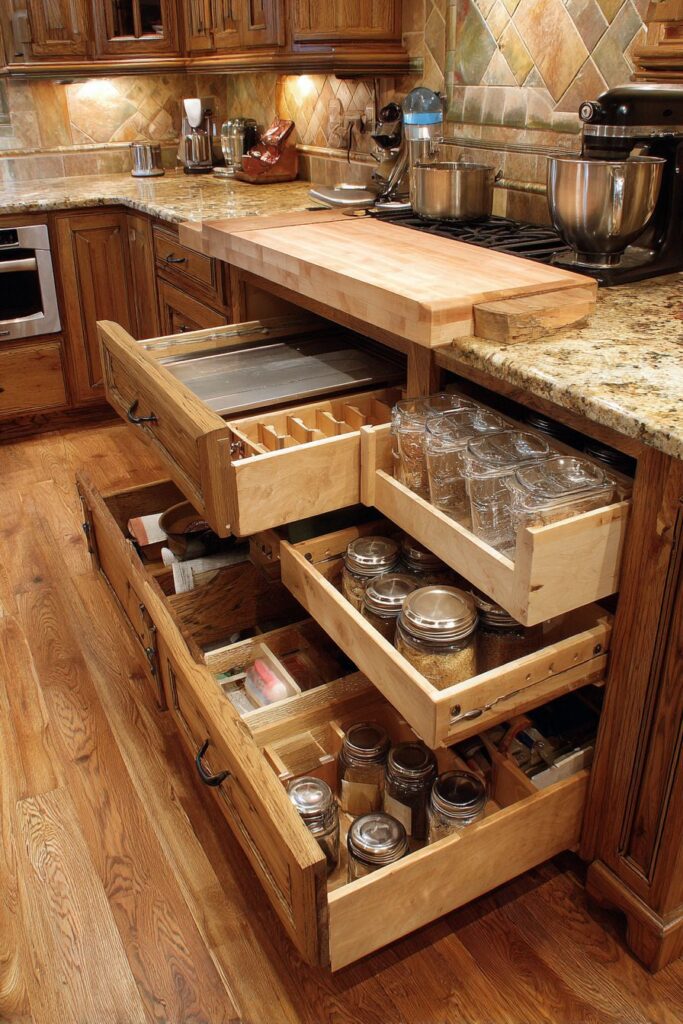
Baking Center Oak Design Elements:
- Create specialized storage for mixing bowls, baking sheets, and equipment
- Add pull-out shelves for easy access to heavy stand mixers and appliances
- Incorporate flour bins and spice storage for ingredient organization
- Choose butcher block countertops for ideal pastry preparation surfaces
- Design functional workspaces that support serious baking pursuits
19. Banquette Seating Oak Integration
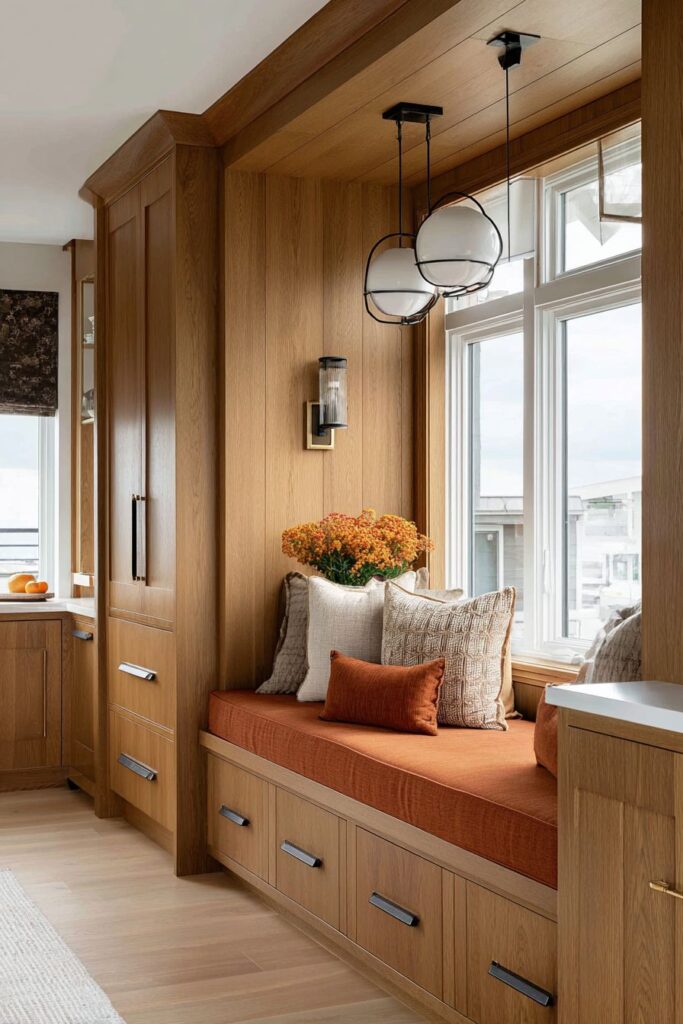
Family-friendly dining receives thoughtful design attention through oak kitchen cabinets extending into built-in banquette seating with storage underneath. The continuous oak finish unifies cooking and dining areas while maximizing seating capacity in space-efficient design. This integrated approach creates visual flow while providing practical benefits for families who need flexible seating arrangements.
Cushioned bench tops in warm textiles complement the oak’s natural tones while hidden storage compartments organize table linens and seasonal items efficiently. The design proves that oak cabinetry can extend beyond traditional storage to create comfortable seating that serves multiple functions. Large windows provide natural light that illuminates the space while highlighting the oak’s consistent grain flow.
The banquette design maximizes seating capacity while maintaining visual continuity with kitchen cabinetry, creating spaces that feel cohesive and well-planned. This approach recognizes that modern families need flexible spaces that adapt to various activities throughout the day, from homework sessions to holiday gatherings.
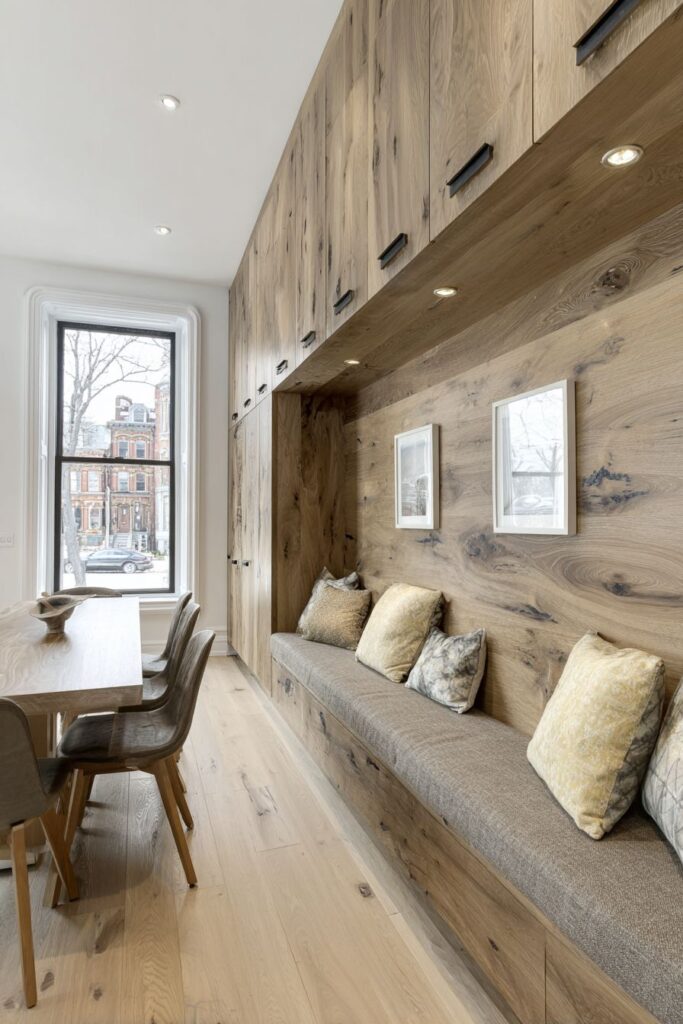
Banquette Oak Design Integration Features:
- Extend cabinetry finishes into seating areas for visual continuity
- Maximize seating capacity through space-efficient banquette design
- Add hidden storage compartments for table linens and seasonal items
- Choose complementary textiles that enhance oak’s natural warmth
- Create flexible spaces that adapt to various family activities
20. Pass-Through Oak Kitchen Connection
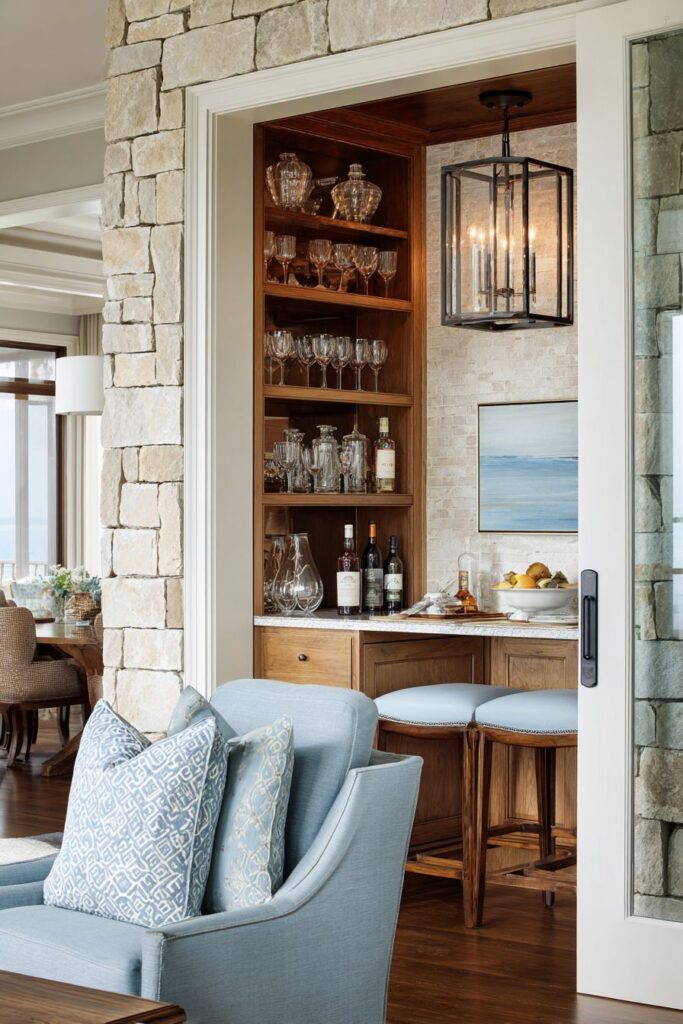
Open-concept living receives sophisticated treatment through oak kitchen cabinets featuring pass-through designs with serving counter integration and bar-height seating areas. The oak cabinetry creates visual connection between kitchen and adjoining spaces while providing convenient serving solutions for entertaining and casual dining. Wine storage and glassware display are thoughtfully incorporated into the oak design, creating functional beauty that serves multiple purposes.
Pendant lighting over the serving counter creates gathering space ambiance while natural light showcases the oak’s rich character throughout connected spaces. The pass-through design maintains separation between cooking and living areas while encouraging interaction and connection. This approach to kitchen design recognizes how contemporary families use their homes for both daily living and entertaining.
The oak cabinetry serves as an architectural element that defines space relationships while providing essential storage and serving functions. Professional installation ensures that the pass-through maintains structural integrity while creating the visual connection essential to open-concept living. This design demonstrates how oak can bridge different areas while maintaining its inherent warmth and beauty.
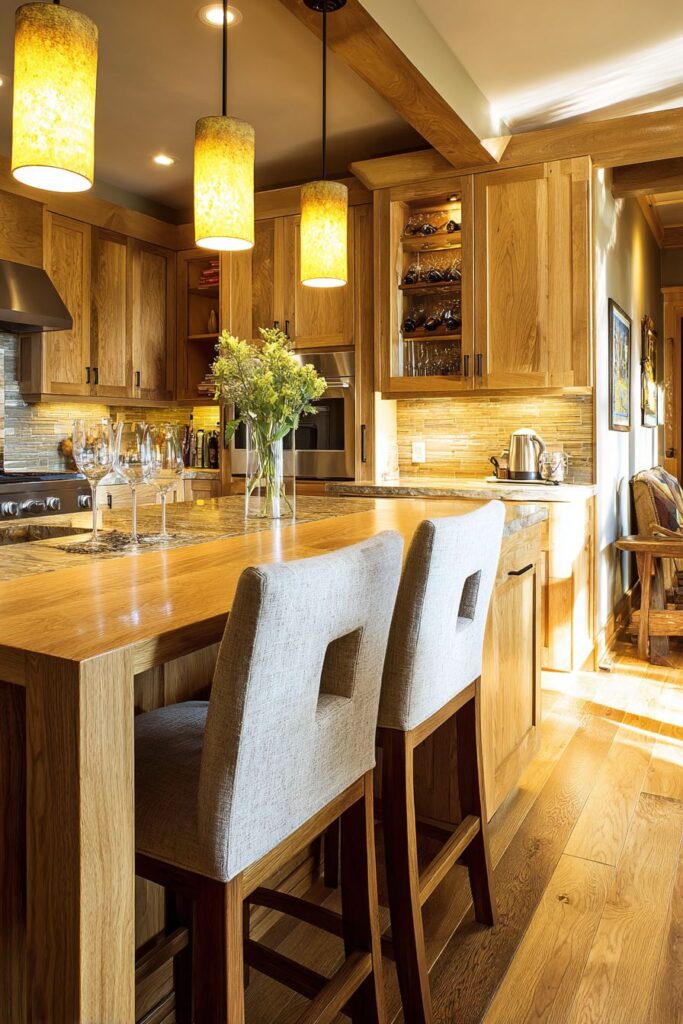
Pass-Through Oak Design Connection Elements:
- Create visual connection between kitchen and adjacent living spaces
- Incorporate wine storage and glassware display for entertaining convenience
- Add bar-height seating for casual dining and social interaction
- Use pendant lighting to define gathering spaces and highlight oak character
- Design architectural elements that define space relationships while maintaining openness
Why These Oak Kitchen Cabinet Designs Represent the Best in Contemporary Home Design
Oak kitchen cabinets have maintained their position as the premier choice for discerning homeowners because they successfully combine natural beauty, exceptional durability, and remarkable versatility in ways that manufactured materials simply cannot match. Traditional raised panel oak cabinets with rich honey tones create timeless elegance that appreciates in value over time, while modern farmhouse interpretations with light oak finishes demonstrate how classic materials can embrace contemporary aesthetics without sacrificing authenticity.
The weathered and distressed oak cabinet options provide character and warmth that cannot be replicated through artificial aging techniques, making them ideal for homeowners seeking authentic rustic charm in their kitchen designs. Scandinavian-inspired bleached oak cabinets prove that natural materials can create the serene, minimalist environments essential to modern wellness-focused living, while transitional shaker-style designs successfully bridge traditional craftsmanship with contemporary functionality.
Contemporary dark-stained oak cabinets challenge preconceptions about natural materials in modern design, demonstrating that wood can be every bit as sophisticated as manufactured alternatives while providing the warmth and character that makes houses feel like homes. Compact galley kitchen applications prove that oak’s versatility extends to small spaces, where the wood’s natural warmth helps create visual expansion while maximizing storage efficiency.
Luxury applications like book-matched oak islands showcase the artistic potential of natural materials when combined with expert craftsmanship, creating focal points that rival fine furniture while providing essential kitchen functionality. Cottage-style painted oak cabinets demonstrate the material’s adaptability to color treatments while preserving its inherent character and authenticity.
Conclusion
Oak kitchen cabinets represent far more than simple storage solutions – they embody a commitment to quality, sustainability, and timeless design that transcends temporary trends and fashion cycles. From traditional raised panel designs that honor centuries of craftsmanship tradition to cutting-edge contemporary interpretations that push the boundaries of what’s possible with natural materials, oak continues to prove its relevance in modern kitchen design.
The twenty distinctive approaches explored in this comprehensive guide demonstrate oak’s remarkable versatility and enduring appeal across all design styles and functional requirements. Whether you’re drawn to the rustic charm of weathered finishes, the sophisticated elegance of book-matched veneers, or the serene beauty of Scandinavian-inspired bleached treatments, oak provides the foundation for creating kitchens that serve both practical needs and aesthetic aspirations.
As you embark on your own kitchen design journey, consider how these diverse applications of oak cabinetry might inspire your personal vision. The natural beauty, exceptional durability, and remarkable versatility of oak ensure that your investment will continue to provide satisfaction and value for generations to come. Whether you choose traditional styling that honors historical precedents or contemporary interpretations that push creative boundaries, oak kitchen cabinets offer the perfect foundation for creating the heart of your home.
